#the reference i used for my version of post-Library River under the cut
Explore tagged Tumblr posts
Note
If I may, I would like to send you the quote "Penny in the air - Penny drops." which wasn't on the list. ("It's mine.....-ish." is also such a good one and so fitting for her btw so feel free to pick that instead). I just think it'd be interesting to pick a Mels quote and interpret it for older River, Idk. If you prefer the list, I would most like to see you do something with either “I hate good wizards in fairy tales; they always turn out to be him” or "Why would a diary be sad?"
Hope you are having a beautiful day, love!
Elle! I am so so embarrassed this took so long to post. I swear I'd written an entire fic months ago but it's disappeared from my docs and I couldn't remember exactly where else I'd placed it so then I made another one. But honestly, I love this version better. Will post the entire fic on ao3 later!! I hope you love it. I tweaked it about here and there to include all the quotes you mentioned.

Tears welled up in his eyes as he gently ran his hand over the cover, his fingers tracing the familiar lines of the intricate illustrations. “Why would a diary be sad?” he murmured softly, speaking to no one in particular.
From the corner of the room, a quiet voice responded, breaking the stillness: “Penny in the air…”
The Doctor blinked, suddenly aware that he wasn’t alone with Kate and Christofer. His attention had been so entirely consumed by the book that he had failed to notice the presence of another figure in the room. He looked up, his eyes widening slightly as his mind tried to process the situation.
“Who—how did you come by this, Kate?” he asked, his voice distant, almost as though he wasn’t fully present in the conversation, still too immersed in the emotions the book had stirred within him.
Before Kate could respond, another voice cut through the air—one that was achingly familiar. “It’s mine... ish.”
The Doctor’s entire world stopped. His hearts pounded in his chest as he turned toward the voice. His brilliant, ever-working mind felt like it had hit a wall, halting as it struggled to comprehend what his eyes were seeing.
She was sitting on the sofa, watching him with a soft smile. The Doctor's breath hitched in his throat as he took in her appearance. She looked older—far older than he had ever seen her. There were streaks of grey in her hair, and laugh lines framed her eyes, adding a new kind of beauty to her features.
River.
His mind stuttered. Beautiful, it whispered. Beautiful, even now.
For reference, I kept this picture of Alex in my mind when writing this post-Library version of River (which is the version I just LOVE writing cause like we have a whole array of pre-Library River already. I want more post-Library River!!)


Also Alex in this role is so fucking beautiful!!!
Also the part "She looked older—far older than he had ever seen her." I wanted it to reflect their meeting in the Library where tells 10 he's so young. Hehe 10River you will always be so angstily special to me<3
divider by @cafekitsune
#thanks for the ask!#*offers a basket of assorted chocolates*#fourteen x river#my writing#fourteenth doctor#river song#kate stewart#christofer ibrahim#BRING BACK RIVER SONG#the reference i used for my version of post-Library River under the cut
11 notes
·
View notes
Text
your voice will save me
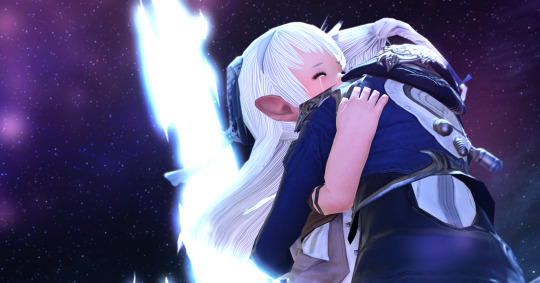
[ ffxivwrite2021 ] ★ [ masterlist ] ★ [ prompt #23 - soul ]
[ alphinaud/wol ] ★ [ 2,416 words ] ★ [ post-5.3 ]
a sequel to a fill i did from last year’s ffxivwrite. i had the idea for this fic for a whole year but never got to write it. aka, it took one year for me to finally give alphinaud closure.
soul- the spiritual part of a person that some people believe continues to exist in some form after their body has died
it’s a long time coming, but alphinaud thinks he should finally tell the warrior of light the words his soul has been yearning to say for thousands of years
Revenant’s Toll feels particularly cold with the nightly breeze, and it sends chills down Alphinaud’s spine as he casts his glance outwards to look upon Silvertear falls, watching as the sky, now free from miasma, is glimmering with a sea of swaying stars that casts distant reflections of light upon the lake where the wings of a great wyrm once stood vigil.
He shivers, grasping at his gloved hand to steady himself, counting his own breaths as he looks upon the tower of crystals with a pang of hurt that leaves his throat dry. The sight of the tower alone reminds him of skyscrapers and the sound of distant rain, and memories that were not his own flash, albeit briefly, through his head like a bolt that strikes at his very heart.
The boy barely manages to compose himself, steel himself with the resolve and cool that a distant, untarnished version of himself had once possessed. Even in the midst of falling stars, a rain of fire and rivers of blood that ran the streets, that man..... himself from an ancient time, Alphinaud acknowledges bitterly with bit lips, he would not allow his emotions to sway him so.
And yet when he hears a familiar voice call out to him from behind, call out to his very soul that has been aching since the beginning of time, he knew that the him of the present was incapable of being as cold and unfeeling as he had once been.
“Alphinaud?” his flower whispers a name into the night, his name. The name of his current form, one that he can barely hang on to as yet another brief flash of a blazing meteor shower tears through his focus. “You called for me?”
“Yes.” He holds his breath, turns around and gazes down at her with a muddied, dishonest smile upon his face. “I....I wanted to talk to you.” there’s hesitation as he speaks, pain laced in his tone, but Illya makes no remark on it as she moves to stand next to the man, crystal violet eyes cast skywards at the dead of the night. “I’m not bothering you am I?”
“You never bother me.” Illya responds swiftly, her fingers resting upon the stone railing and shivering a tad as she finds the surface cool to the touch.
He swallows the lump in his throat, eyes averting her own and body fidgety, restless as he attempts to find the words in him to even begin speaking - because heaven knows there are so many he wants to say to her.
Previous countless mental rehearsals are now forgotten, replaced with only the raw emotions of a flickering, barely visible light within him.
“I.... I just wanted... To call you out here to... Well... clarify some things... and... and to apologize for others...”
His voice is sheepish, timid, completely unlike the assured confidence of her beloved scholar who had been so eager and ready, eyes blazing with confidence during his fight against the specters of light, his magicks woven from his passion like bursts of fire and gusts of summer wind.
But her smile is still patient and kind as she watches him carelessly stumble upon his words, a hand raising up to tuck a long fluttering strand of hair behind her ear as it blew effortlessly in the lake breeze.
“I never did apologize... Well, there are a lot of things I have to apologize for but-” Alphinaud frowns, “I-I.. I could not well carry on without first trying to apologize to you for all of my transgressions.” Inhaling sharply, the elezen clenches his fist and casts his gaze down upon the stone under his feet. “I’m sorry for worrying you so much all the time, especially when my soul had been pulled to the first. I’m sorry for not being there for you when you struggled with yourself... I’m sorry for putting you through such heinous betrayal because of my incompetence as a commander of the Crystal Braves. I’m sorry for all the times I used you, doubted you, hurt you...”
His voice shakes with the sorrow worth many years of regret, of the guilt he’s pent up and swore to himself he’d make amends for. His heart is aching, the agony of his own past sins coming back to haunt a more mature, wiser, older form of himself now. But he knows it is nothing compared to what he has put her through.
“When we first arrived in Ishgard, I promised you that I would do better - be better for the sake of the others and you who I have wronged. I don’t know if I’ve gotten far enough yet to say I’ve fulfilled that promise... And for that too, I am truly sorry.”
lllya parts her lips to speak, but her voice is hushed, watching as what little shred of dignity has drained from Alphinaud’s navy blue eyes with a sea of cyan sadness washing through her own. And when she takes a step towards him, he holds his hand up and she swallows back her protests reluctantly, intent to listen to his heart until the end even if it killed her to do so.
“And... and also... I’m sorry for pushing you away.”
That statement applies to himself from six summers ago, but the distant glaze in his eyes as he attempts to recall memories of a long forgotten city tells the girl that he was referring to otherwise, and she casts him a confused tilt of her head before he finally speaks again.
“In a time long past... in a city of creation and innovation... That man, Apollo...” Alphinaud shakes his head. Saying another name that was not his own would be deflecting the blame, “the unsundered form of myself sought to reach distant heights that I believed not even the convocation could dream to match. And in my vain, egotistical pursuit for ideals that I wasn’t worthy of I...” He chokes back a sob, the thought of his sins against her too much for even himself to even recount. “I hurt you. I told you such blatant, awful lies. I let my jealousy and my own incompetence sweep me away. I-”
“Alphinaud.”
Her voice calls out his name. His name. The name of his current form - his present form. It is the only name Illya knows and will ever acknowledge.
And though her expression is stern, eyebrows furrowed and peach pink lips pressed into a tight line, she still says his name like melted caramel, unbearably sweet and warm in its tone.
“I can accept your apology for everything else. I forgive you. But you’re beginning to apologize for mistakes that aren’t your own.”
“But I am- I mean... it... is me.”
In a way, he acknowledges... Not fully, of course... but the revelations of what had been his past life is proof enough that he, even if a fourteenth fraction of what had once been the man named Apollo, he still must bear part of the responsibility.
He’s lucky enough as he is to have been granted a second chance, just as Apollo had begged and prayed to the heavens for. He cannot even fathom a world where he had not met Illya anymore.
His beloved smiles, hand raised up to press against her beating heart, as if to feel the essence of her twice rejoined soul. She searches for whispers of herself - of the perfection version of the woman she once was, feeling the bright amethyst constellation stone that bore the insignia of the blistering sun warm in her pocket. She hears no words, only a wave of emotions that cascade through her and almost sweeps her away - she has after all ever been the most sensitive with the voices of unseen beings.
But even with the two shards of a whole soul shone brightly within her, and she can almost envision the visage of a dusty, quiet library in her mind, there is not a trace of anger or hurt in her heart.
“I am Illya Skawi. And you are Alphinaud Leveilleur.” Her gentle tone belies the weak little tremble in her voice as her eyes swirl with an ocean of unfiltered emotions. “I am nowhere near as perfect as Chloris, I know I can never be.” Her hands clasp together tightly, held close to her chest as if to guard her heart. “I may inherit her will... but I will never be her.”
Where Chloris had bright, flawless sanguine pink eyes that morphed in hue to reflect her thoughts, Illya inherited a pair of more timid orbs of lavender twilight. Where Chloris had unmarred skin of a porcelain doll, Illya’s skin was covered with a map of the galaxy - the speckle of stars from bullet holes upon her thighs, the milky way that cut across her collar bone and the auroras taking the form of teeth marks all over her abdomen.
And where Chloris had an unparalleled talent for optimism, charisma and hope, what remained in Illya was only the painful, unreciprocated love she had for the world that would be the very bane of her mental stability for as long as she can remember.
Even with her soul reunited with Ardbert’s, she knows she is but a husk of what had once been the fourteenth member of the convocation - of azem... Emet-Selch at least wasn’t mistaken in spelling that fact out.
“And the woman that Apollo loved is not me - not this ugly, fragmented, weak little shard as I am.”
That’s absolute nonsense, Alphinaud wants to retort. Illya is anything but. It may not who Chloris had once been - but it is who the woman he loves is. Whole, beautiful and divine, her hair is woven from moonlight and her eyes are pressed from a bouquet blossomed flowers. Her voice a melody of a songbird, her skin a distant and unexplored, yet welcoming cosmos. She is a ray of hope, not just for him, but practically everyone else he knows... and he could think of no better personification of perfection than her.
The world may disagree, the ancients may cry in protest and the whole, unbroken version of him may think to question his judgement.
But Alphinaud knows, even if he is wrong about everything else and will continue to be as imperfect and sinfully tainted as he is, that he isn’t wrong about her.
“You’re not- You are not....ugly...” the words die at his throat, he’s lacking in the strength to debate as fervently as he is usually capable of doing. “Or weak for that matter. You’re...”
“I’m not Chloris. And you’re not Apollo, either. Perhaps we were once upon a time, but not now, not here.”
The breeze picks up and howls in his ears, carrying the chill of his doubts and guilt away into the night. And as the bearer of hopes and miracles flashes him a radiant smile, he feels his chest clenching with a warmth that he can barely contain.
Illya turns to look back over Silvertear falls, the light from the moon and the fields of crystals casting a halo over her hair as it fluttered like a veil in the wind. Her skin glows with color, warm against the backdrop of grey stone and dark blue sky.
“I did ponder over the circumstances of our meeting... If it was pure coincidence or a mechanism of fate bringing their souls... our souls together again.” Illya hums, fiddling with her fingers as she contemplates out loud. “And I wonder... if the other shards of Chloris and Apollo are so tightly wound together that they’d meet again in other worlds too...”
“They will.” He answers on impulse, as if his entire being already knew the answer. “I believe they will.”
It’s a naive and an impossibly idealistic wish... one with a hint of selfishness and ego too, perhaps... but those are the core of who he is- who his soul is. And if Apollo loved Chloris even half as much as he loved Illya, then he knows, is certain with all his heart that the thread that keeps their fourteen souls tied together for eternity will not be so easily severed.
There’s a quiet that looms over them, with only the sounds of the wind and the chirping of the crickets ringing in the air. Illya doesn’t turn to look back at him for a minute, lost in her own thought and drowning in a pool of her own emotions - thousands of years worth of them.
“That’s good. I’m glad...”
When the girl turns around, her violet eyes are wet with crystal clear tears, they catch the rays of moonlight and reflect off her face as they roll down her cheeks past upturned lips.
“Because Chloris loved Apollo, you know? She loved him very very much.”
Alphinaud hadn’t noticed when he’d started crying either, quiet sobs breaking out of him as he lets out a choked laugh, raising a gloved hand to feebly wipe away his tears.
“He did too. He loved her so much that it killed him.”
His heart is so full to the brim, spilling with unbearable adoration and devotion. When Illya spreads her arms out wordlessly, sniffling back her own trickling, glistening tears, he picks her up and wraps his arms tightly around her, feeling the beating of his heart match in tandem with her own.
In their warm, tender embrace, he hears the echoes of a distant past - yet another vision of a splitting star flashes in his mind. But he doesn’t flinch this time as he holds his entire world in his arms, afraid and determined to never let go.
“I love you. I love you.” Her declaration is all he hears, along with quiet whispers of his name. His real name.
Alphinaud. Alphinaud. Alphinaud. Alphinaud.
This love was hers to bear, and no one else’s - not Chloris, not Ardbert, not the twelve other flickering star blossoms that are out there, undoubtedly fighting with their entire being to reunite with their own other half. And no cry of ancient beings, no fracturing of worlds or falling of the moon or stars will stop her from loving him. Even until the sun sets, even until the end of times.
And though their souls may have been set adrift, he knew that his soul would always be destined to love hers in return.
“I love you too, Illya.”
#ffxiv#final fantasxy xiv#ffxivwrite2021#ffxivwrite#kiwisffxivwrite2021#illya skawi#alphinaud leveilleur#alphinaud#we've come so far#fanfic#mine#THIS IS A RESULT OF A WHOLE YEAR OF THINKING ABOUT THIS IDEA AND THEN THIS PROMPT CAME OUT#I actually wanted to write this RIGHT AFTER i wrote that fill from last year but#i got lazy hue... as usual#hey this turned out pretty good though so#I LOVE THEM SO MUCH GOD THEY DESERVE THE WHOLE WORLD AND MORE
18 notes
·
View notes
Note
1, 2, 4, 10, 20!!
Tell us about your current project(s) – what’s it about, how’s progress, what do you love most about it?
Oh boy so I’m sure I must have mentioned it at some point but I won’t turn down a chance to ramble about it again: me and @regalpotato are working on a Day of the Doctor rewrite and I’m pretty psyched about it! Basically, Eight is there rather than War (although War does make an appearance!) and also River is there, because Duh, and there are other Things going on that are different from the episode/novel, but that’s spoilers and also still partially cooking in my brain, lol. It’s at 11k-ish right now but still pretty early in the story, too early to probably say what I will love most. But I’m having a ton of fun with it, especially the dialogue, and currently torturing Ten in every way I can think of. You know, lovingly torturing. For the most part.
That is the really big thing I’m excited about, but I do still have two prompts left from a couple weeks back (I didn’t forget you, anons!) and those are milling around in my head too waiting for inspiration to strike. 2. Tell us about what you’re most looking forward to writing – in your current project, or a future project
No secret that I love writing multi-Doctor / River stories, and in fact having somewhat recently finished an 8 and 11 / River fic I will have to be on my toes to not repeat myself too much haha. But I just love getting everyone together and letting them yell at each other for a while - the best honestly - and then later we get Revealing Conversations about Feelings, as well as POV changing chapters. Not to overhype it but! I think it’s gonna be fun! Putting the rest under a cut because I am long-winded lol.
4. Share a sentence or paragraph from your writing that you’re really proud of (explain why, if you like)
Hmmm I’ll pick something I like from the WIP that’s all my writing - this is from Night of the Doctor with Eight and Ohila, but it’s diverged from the original script here and iirc pretty much all new dialogue for Eight. I don’t normally write this sort of Doctor speech because I’m usually doing romance, but I can hear Paul McGann righteously shouting/soliloquizing in my head so I’m pretty happy with it: *** “What would you have me do?” the Doctor hissed. “What does your broken prophecy foretell? That I become one more loyal soldier in Gallifrey’s glorious army? I can join this fight and take a thousand lives, die a thousand deaths, and this war will still go on. The universe doesn’t need another soldier!” “Not a soldier,” said the Sister, “a warrior, with the power you’ve refused to wield. You could have destroyed the Daleks before they were even created.” “Yes, I could have done. And I didn’t, because I have no right! Whatever it is you think you can turn me into, Sister, you’ll continue to be disappointed. Because there’s one person who is always needed in a war: a good doctor, willing to help whomever they can. No matter if they’re despised, or called traitor— no matter who they lose or how many times they fail! There will always be more lives to save, and I’ll be there, helping, wherever I can. I only hope I’m strong enough to carry on doing it half as well as another doctor I knew.” ***
(Yes of course we have Liv Chenka references!) 10. How would you describe your writing process? It takes me forever to get ideas, but once I have a sort of general amorphous direction for the story and an emotional starting point for the characters, I just jump in. And then I keep getting shower thoughts about more and more stuff happening and what was supposed to just be some fun fluff starts growing a plot and getting wildly out of hand and this is just my life. I am very much not in control. 20. Tell us the meta about your writing that you really want to ramble to people about (symbolism you’ve included, character or relationship development that you love, hidden references, callbacks or clues for future scenes?) Ohhhh this is such a good question! Definitely going with There is a love I reminisce because there’s a lot going on under the surface in that fic and not all of it stated super explicitly. So um, huge spoilers below if you haven’t read it!
Manhattan and Trenzalore (both times) are essentially retconned, through a combination of River’s innate abilities and Eleven going around the timeline trying to do better after being confronted with his shortcomings in TNOTD. How the Doctor survived Utah is explained and it’s not because he was in a stupid robot. It spawns an implied post-Library reunion with River, Eleven and the Doctor’s oft-referenced and never quantified or named children from Gallifrey. It implies a different resolution to the Hybrid thing and an alternate series 10. And of course it uses BF’s far-superior Ravenous 4 plot twist to preemptively annihilate the timeless children crap, and a combination of Ravenous 4 and Doom Coalition 4 to make River basically a time goddess. But maybe my favorite thing was giving life to this headcanon of mine. IT CANNOT BE REFUTED! They’ve never said ANYTHING specific about his family so it’s free real estate baby!
*** “Yes, sorry to harp on about this, honey, but I think we can discuss the regeneration semantics later,” River cut in. “You’re saying I came back from your future to your distant past and just… stayed?”
“Well… yes, I think so. There were certain things we couldn’t discuss. I had always just assumed that I’d reached the end of my last regeneration and you weren’t too pleased with that, so… You know, describing it now, it does seem very irresponsible. But I don’t recall having any complaints.”
“No, I shouldn’t think you would.” River smiled, but her mind was racing. “How would that even work? Eventually, we’d come back round to when we first met on your end, and what, I wipe myself out of your memories? Selectively, for your entire lifetime? I think you might notice a little thing like that.”
“I suppose you must have had a plan for it, but I can’t remember it now. I just remember the two of us, together through the centuries.” He smiled fondly and River felt like the ache in her chest would strangle her. “I remember our family.”
“Our what?” she cried, as the older Doctor had a sudden choking fit.
“Our family. Our children and…” Dread slowly dawned on the young Doctor’s sweet face. “Oh, please, no,” he whispered. “Don’t tell me they’re… No, this happened! It happened in both versions of my memories!” He looked to his older self, panic-stricken. “Tell me you remember!”
“You had a family,” River soothed, as Babyface stumbled over his own tongue. “It just wasn’t with me.”
“What?” he laughed incredulously. “Who else would it be?”
“Your first wife, sweetie. I’m your second. Well, the second one that counts.”
“No, that’s— I’m sorry, that’s nonsense.” He turned to the older Doctor again. “You can’t tell her, is that it? Because she hasn’t done it yet? I’m sorry, River, maybe I shouldn’t have—”
“No!” Babyface shouted, finally collecting himself. “Yes, we— I had a family, on Gallifrey, before I ever left. River wasn’t there, obviously, because that’s not how anything works!”
“Who, then?” the young Doctor demanded. “Who was your first wife?”
“I— I— she was—” He opened and closed his mouth silently, looking increasingly horrified.
“You don’t like to talk about it,” River explained. “She passed away.”
“Yes, but just between me and myself,” the young Doctor pressed on with an utter absence of tact that made it easier than ever to see this was the same man before her, “who was she? And your children, what were their names?”
River hesitated, watching as the older Doctor wrestled with himself. These were details not even she had ever asked him for. She knew the general outline, of course, and that was enough. It was a hurt so deep and so impossibly ancient, she couldn’t truly imagine how distant it must be for him now. No sense in forcing him to open that door and dwell on it again.
“I, I don’t,” he finally muttered, looking almost fearful, “I don’t talk about it. I don’t think about it.”
“You’ve forgotten them,” the young Doctor said, voice low and furious. “How could you?”
“S-Susan,” Babyface stammered, wide-eyed. “I left Gallifrey with Susan.”
A relieved smile flashed across the young Doctor’s face. “And where did you suppose she came from?”
“No, she… I don’t…” Chair legs scraped abruptly across the tile as the older Doctor bolted up from his seat, white-faced, and stumbled back from the table.
“Doctor?” River stood, her hearts racing.
His eyes met hers for a split second, the strange terror in them sending a chill through her, and then he was gone like a shot.
“Doctor!” She made to chase after him, but his younger version was still clasping her hand.
“He’ll be fine,” he reassured her. “He’s just working it out.”
“Working it out?” she repeated, too stunned to reach out and grasp for the obvious. She turned to him in a daze. He smiled, and for a fleeting moment she fancied she could see the long contentment of a life she’d never dared dream of, etched in each little line on his older, younger face.
“I told you, River.” He laid his other hand over hers, warm and steady. “It was always you.” ***
#thank you so much for these they were great questions!!#i need to like shut up though these are such long answers lollllll#amillionmillionvoices
6 notes
·
View notes
Text
BBC Dracula - Moffat and Gatiss (review) 2019
I’m putting most of this under the cut, so I don’t spoil anyone who hasn’t seen it yet (it’s now on Netflix for international audiences).
Contains some discussion of queer-coding/ queer-baiting, and some discussion of Sherlock “Easter-eggs”.
Claes Bang is an amazing Dracula.........
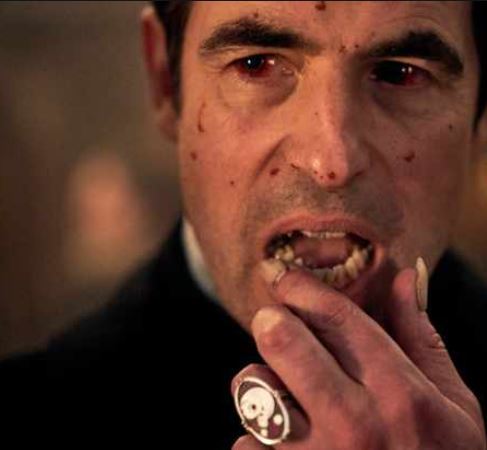
I know Moffat and Gatiss are frequent hate-objects on Tumblr. And I think, unfortunately, there can be a “contagion of hate” which happens in relation to creatives online, which is different from thoughtful critique of the work.
They are, in my view, good writers and (as are we all) flawed humans.
I’ve enjoyed their Doctor Who, their Sherlock and now their Dracula, whilst, at the same time, being critical of some elements (e.g. Moffat writing Amy, River AND Clara as “mysteries” for the Doctor to “solve”, as if women, a la Freud, were inherently mysterious, or their version of Sherlock’s contemporary London as, almost entirely, white, when London’s population these days is 30-40% BAME).
However, if we can only enjoy totally “unproblematic” art, there will be precious little art left to enjoy.
Sherlock, in particular, became embroiled in the great queerbaiting debate.
And I think that raised a number of interesting questions, and complex questions, about different generations of LGBTQ+ people, their expectations, histories, and (sadly) failure to communicate well with one another (inter-generational queer culture can be regrettably absent, as there are often no social spaces for it outside sexualised spaces).
Moffat and Gatiss (the latter is gay) at once openly disavowed and archly acknowledged the queer subtext in Sherlock in interviews, whilst BBC PR (and this element, I think in particular, was problematic) frequently used it as part of their marketing for the show.
Moffat here appears to disavow Sherlock as gay:
"There's no indication in the original stories that he was asexual or gay. He actually says he declines the attention of women because he doesn't want the distraction. What does that tell you about him? Straightforward deduction. He wouldn't be living with a man if he thought men were interesting."
Moffat is not saying that Sherlock, like Austin Powers, misplaced his mojo. "It's the choice of a monk, not the choice of an asexual. If he was asexual, there would be no tension in that, no fun in that – it's someone who abstains who's interesting. There's no guarantee that he'll stay that way in the end – maybe he marries Mrs Hudson. I don't know!"
https://www.theguardian.com/tv-and-radio/2012/jan/20/steven-moffat-sherlock-doctor-who
And also here:
“[Sherlock]’s not interested in [sex]. He’s willfully staying away from that to keep his brain pure — a Victorian belief, that. But everyone wants to believe he’s gay. He’s not gay. He’s not straight.”
https://www.vulture.com/2015/03/sherlock-is-not-gay-not-straight-steven-moffat.html
Whilst Gatiss, on the other hand, here acknowledges a homoerotic subtext, which he prefers as subtext:
“No, I don’t think I’d make a kind of gay programme. It’s much more interesting when it’s not about a single issue. And equally, I find flirting with the homoeroticism in Sherlock much more interesting.”
http://content.yudu.com/Library/A1p89f/BuzzMagazineOctober2/resources/index.htm
Buzz Magazine, Oct 2010.
In viewing their, post-Sherlock, Dracula, I think Moffat and Gatiss have taken on board some of the “queerbaiting” accusations (although don’t expect them to admit it).
For instance, in Sherlock, the only confirmed LGBT characters on-screen are Irene Adler and her companion, and Kenny Prince and his housekeeper/ lover Raoul (there is also John Watson’s sister, whom we never meet on-screen). All the main male characters who might be queer, remain queer-coded - Moriarty, Sholto, Mycroft, Sherlock, John Watson himself.
In Dracula, it is clear that Drac himself is a seducer of both men and women. Yes, Moffat refers to him as “bi-homicidal” not bisexual:
https://www.pinknews.co.uk/2019/12/28/bbcs-new-dracula-is-bi-homicidal-not-bisexual-yes-really/
I don’t have a problem with that. Bram Stoker’s Dracula was all about feeding not overt fucking too, but his “desires” for male victims were more sublimated - it was Mina and Lucy he most directly targetted, and his vampire “brides” at the castle were all women. What we see on-screen in Moffat and Gatiss’ version is a more overt equal opportunities gorging, on both men and women, using the tropes of sexual seduction (hands on knees, intense looks, suggestive conversation). In that sense, Moffat and Gatiss are bringing the subtext of the original much further into overt text. Their Dracula is being read as bisexual by audiences who don’t approve as well as audiences who do (i.e. it’s pretty damn visible):
https://www.gaytimes.co.uk/culture/131015/viewers-defend-dracula-being-bisexual-in-terrifying-new-bbc-series/
https://metro.co.uk/2020/01/02/calling-dracula-gay-vampire-totally-misses-point-11991772/
Alongside that, there are several LGBTQ characters, including Lord Ruthven (a nod to Polidori’s The Vampyre, 1819) whom Dracula seduces. Renfield (played by Gatiss) and Jonathan Harker, are also “enthralled” by the Count, with Agnes Van Helsing directly asking Harker whether he had “sexual intercourse” with Dracula, and Gatiss’ Renfield appearing quite besotted with the Count.
But the key to this version of Dracula is the relationship between the Count and Van Helsing, whom Moffat and Gatiss have re-written as a nun, Agatha Van Helsing, incorporating also some of Stoker’s original Mina into the character as well.
The three episodes, “The Rules of the Beast”, “Blood Vessel” and “The Dark Compass” are set 1) In Dracula’s castle, in the original time-period of the novel, 2) On the Demeter, the ship Dracula takes to England, in the original time-period of the novel and 3) In the present day UK.
Episode one was a hammer-horror tribute, really. Episode two was an Agatha Christie tribute (and a nice piece of fan-fiction too, as it fleshed out the novel’s account of the voyage). Episode three was, really, in many ways, a tribute to their own Sherlock.
Their Van Helsing was brilliantly written and brilliantly acted by Dolly Wells, as a sort of Sherlock character - celibate by choice, cold, brilliant, and absolutely commanding.
I think this Dracula played with the source material quite beautifully (“bloofer lady”) and found a way to incarnate the Victorian gothic themes of sublimated carnality, purity, corruption and death into the contemporary world.
Claes Bang’s Dracula is a creature of mesmerising seduction, but he is, in fact, always seducing himself, searching for “brides” who seem not to fear death (which he personifies, in the midst of his rotting eternal life) and forever coming up short.
And Agatha Van Helsing, his counter-part, his match, is, as a nun, a woman who has sworn vows of anti-seduction (celibacy).
But she does seduce Dracula, and she does it with her mind, through her own fearlessness, because she is so open about her doubt in the reality of God and salvation, yet she is bravely ready to meet her death anyway (twice).
I loved the final tableau of Death and the Maiden, only it is the maiden who seizes hold of death, even across time, and in the end wrests the Count into the loving arms of the finite.
I think Moffat and Gatiss definitely had some fun, in terms of thematic cross-overs with their Who and Sherlock, quite apart from the evident cross-over casting (Jonathan Aris, who played Anderson in Sherlock, appears in Dracula episode 2 as the Captain of the Demeter, and Sacha Dhawan, who plays The Master in the new Doctor Who episode “Spyfall” which just aired, also appears in Dracula episode 2 as Dr. Sharma).
The time travel element was there – Agatha “re-incarnated” in her descendant Zoe and then inhabited by her spirit (via blood transference) and so was the duelling “frenemy” dynamic of the Master vs The Doctor and Sherlock vs Moriarty, echoed again here in Dracula vs Agatha.
I suppose we could say that all three productions (in Moffat/ Gatiss’ hands) share the sentiment that real seduction happens in the mind.
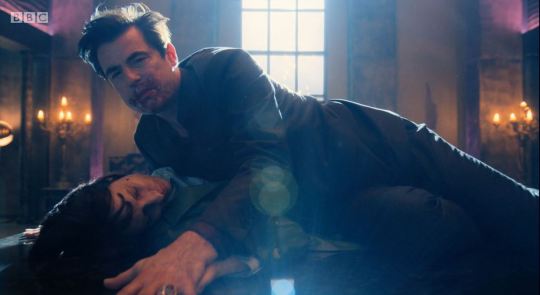
Agatha, of course, drinks Dracula’s blood in episode 3, and, given much subsequent vampire lore (e.g. The Vampire Diaries) which frequently attributes healing properties to vampire blood, it is quite possible that both she and the Count survive what seems to be their final encounter in “The Dark Compass” - her blood no longer deadly to him, as his blood heals her cancer.
The “game”, as Agatha/ Zoe says, is not, in fact, in that case, “over”.
For Sherlock fans looking for cross-over textual commentary, there was plenty, including that reference to “the game”, a favourite saying of BBC Sherlock’s - “The game is afoot!” and, of course, episode 1x03 The Great Game.
Agatha and Dracula play chess on the Demeter, in Agatha’s mind. And if you listen, as they sit down to play, a few bars of the Sherlock theme tune play:
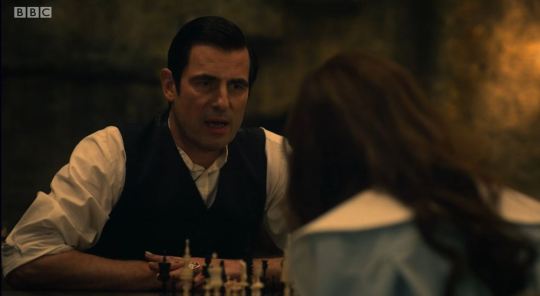
Remember this publicity shot for S4 of BBC Sherlock?

With its perhaps give-away pieces flying at John like bullets?
The fact that Agatha and Dracula’s chess game takes place in her mind, whilst, in fact, as she later realises, she is dying (being drained of her blood by Dracula) could be read as giving credence to the theories that S4 of Sherlock, in fact takes places significantly in John’s mind, whilst he is lying in a coma after being shot.
Dracula also refers to “the losing side” in relation to the chess game, as being Agatha’s. And that phrase is used by Sherlock - ”sentiment is a chemical defect found in the losing side” in A Scandal in Belgravia in his confrontation with Irene Adler, when he guesses that she has used his name as her phone password. Dracula is eventually bested by Agatha because he succumbs to sentiment - he cares about her.
Lucy rather resembles the bride of The Abominable Bride (as she becomes the abominable “bride” of Dracula) and Agatha Van Helsing is very much in the vein of the suffragettes who outsmart Sherlock in that episode.
Key take-away being that dreamscapes are a common feature of Moffat and Gatiss’ Sherlock and Dracula - Sherlock’s drug-dream of The Abominable Bride, John’s possible coma-dream of much of S4, and the dreams Dracula’s bite gives to Harker, Lucy and Agatha.
Things are not (simply) what they seem.
Dracula also talks a lot about mirrors - he avoids them because they tell him the truth about his living corpse, whereas, interestingly the mirror lies to vampire Lucy, showing her a still-beautiful and un-burned version of herself (whilst the selfie tells her the truth). Mirrors, of course, featured heavily as a narrative device in BBC Sherlock (e.g. Molly as a mirror for John).
There’s plenty more to say, but I’ll leave it there for now!
#BBC Dracula#BBC Dracula Spoilers#BBC Dracula review#Dracula#BBC Sherlock#Sherlock and Dracula mirroring#The great queerbaiting debate#Dracula meta#Reading subtext#My Miscel Meta
57 notes
·
View notes
Text
Neighborhood #12: Āgenskalns
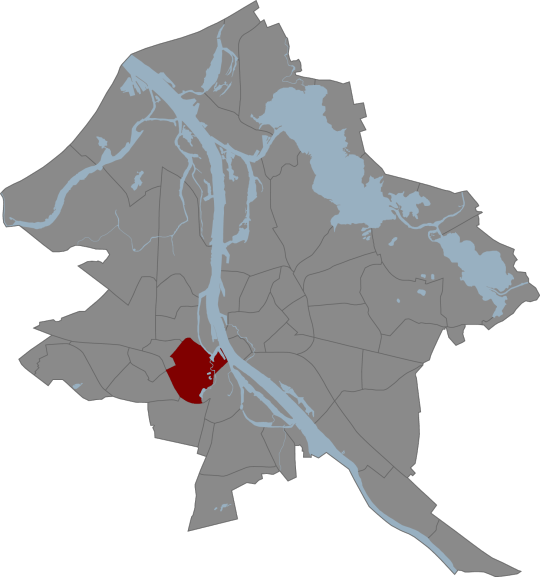
Name: Āgenskalns Meaning: Translates roughly to “Agens Hill” Area: 4.61 km2 (27th) 2014 Population: 27,923 (9th) 2008 Population density: 6538 people/km2 (11th) Distance from Riga Central Station by public transit: 8 minutes (train) Public transit lines: #3, #4, #4z, #6, #7, #8, #13, #20, #21, #25, #38, #39, #47, #50, #51, #52, and #55 busses; #1, #5, #9, #11, #13, #18, #22, and #23 trolleybusses; #2, #4, #5, and #10 trams Places of interest: Kalnciema Kvartāls, Uzvaras parks (Victory Park), Āgenskalna tirgus (market), Māras Dīķis, Alises torņis (water tower), Date of Visit: March 18, 2016
Last month we visited the cultural hub of the Pārdaugava region: Āgenskalns. One of the city’s most well-known and instantly recognizable areas, nearly anyone who has ever crossed the Daugava river to the city’s western half has been through at least a bit of the neighborhood, as two of the city’s four bridges cross into it. From Vecrīga, it’s just a five-minute walk across Akmens tilts (stone bridge).

While the Rīga-Tukums line makes for a logical southwest border and the rivers clearly cut the neighborhood off from the rest of the city, the other borders seem a bit arbitrary and fuzzy. This is even more apparent when looking from above. Many people refer to a much greater area than just that in the red lines as “Āgenskalns,” while others might consider much of that northern area above Kalnciema iela part of of Zasulauks.
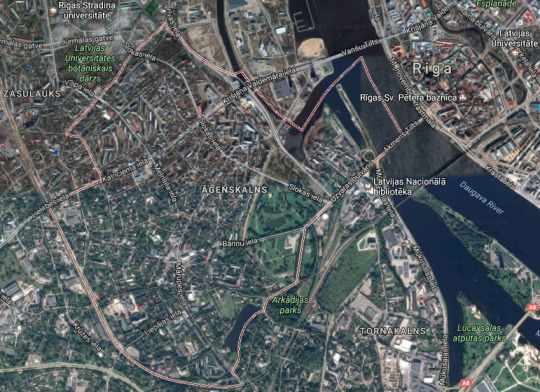
The good news was that we would be exploring Āgenskalns with our friend Konstantin, a life-long resident of Rīga with an encyclopedic knowledge of the history of the city’s buildings thanks to many hours spent researching online and in the city’s archives. Even better, he’s from the neighboring region of Zasulauks just to the northwest, so he was able to provide us with particularly generous wealth of information about Āgenskalns. The bad news was that the only day that him, Līga and I could all go together happened to be the one rainy day in a string of otherwise perfectly sunny and relatively warm days. While Konstantin’s philosophy was that this part of Rīga looks good even in gray and drizzly weather, I feel a bit bad that we weren’t able to do this beautiful neighborhood justice with such dreary backdrop.
Līga was a bit busy earlier in the day, so I met Konstantin by myself first to check out the area by the river before she would join up with us a bit later. I got on a #3 bus from the station and took it just two stops before getting off at the Nacionalā bibliotēka (national library) stop where I met up with Konstantin.

We started on towards the river, walking first by a beautiful pinkish pre-war building that Konstantin told us was used by the Soviet government as a teacher training academy. Apparently during Soviet times teachers were not required to have a university-level education, so it was something more akin to today’s trade schools. To the immediate left was what looked at first like a newly renovated pre-war building until Konstantin told me about the interesting history behind it. Apparently it was a derelict abandoned building before Latvia hosted the EU Council presidency back in early 2015. Since the library across the street was to be used to host dignitaries throughout the six months, the city ordered the owners to give the building a facelift, resulting in a freshly painted skeleton. I couldn’t believe this until we got closer and I was able to see inside for myself.



It’s inconceivable to me that this prime real estate so close to the river and tram lines had not been properly renovated by some savvy developer, but there are many other situations just like this throughout the city. Across the street was a somewhat unusually decorative Hruščovka with an interesting brick pattern. I might not have mentioned it previously, but one interesting thing about at least the brick version of these Soviet projects is that the year is usually inscribed at the top using differently colored bricks.

Continuing down the road, we came to an abandoned old police station across the street from a 90s-era housing construction. As is the problem with nearly any city in the world, it was sad to see such a beautiful structure fall into a state of disrepair which at this point would probably prevent it from being reconstructed in an economically efficient way. Its juxtaposition across from those modern condos were a bit poignant in illustrating how preservation can be lost as an urban priority.



Just a bit further on, we crossed onto the AB Dambis, a large jetty first constructed from wood in the 1880s to regulate the Daugava's flow and for loading and unloading boats. The structure was destroyed by the German army during WWII before being reconstructed in its current form by the Soviet army. If you're interested in learning more about it's history, you can check out this post from Cita Rīga (in Latvian, but can be translated). We walked out to the furthest point and took a few pictures of Vecrīga's skyline and of where we would soon be walking in Āgenskalns.
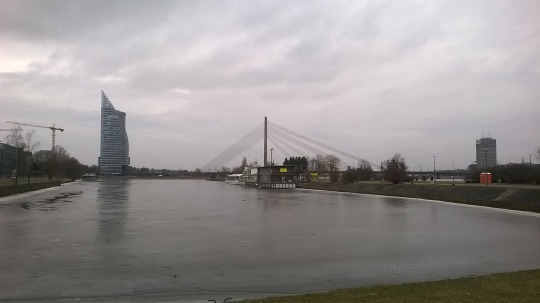



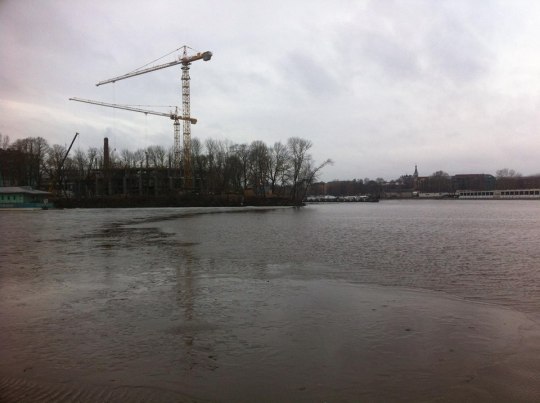
I got a call from Līga who said that she would meet us soon at the same libary bus stop where I had met Konstantin, so we started heading back in that direction. After waiting about ten minutes at the bus stop, we finally met up with Līga and started down the gray brick road of Valguna iela. To get there we passed under a concrete residential building which like a few others in the neighborhood had been constructed over the road itself. According to Konstantin, this was an “experimental” residential project which was not replicated due to its uncomfortably cramped living conditions and non-intuitive navigation on the inside. Along this road were a row of Stalin-era buildings on the left and some older wooden ones on the right.
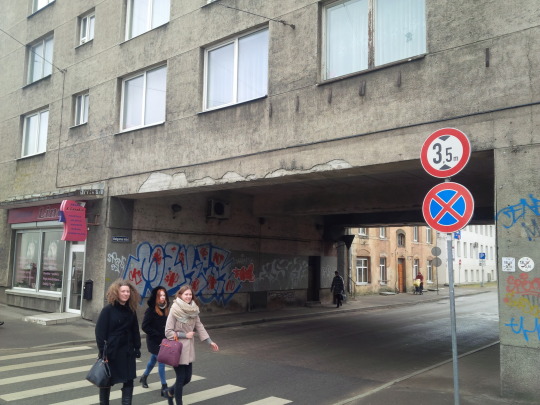
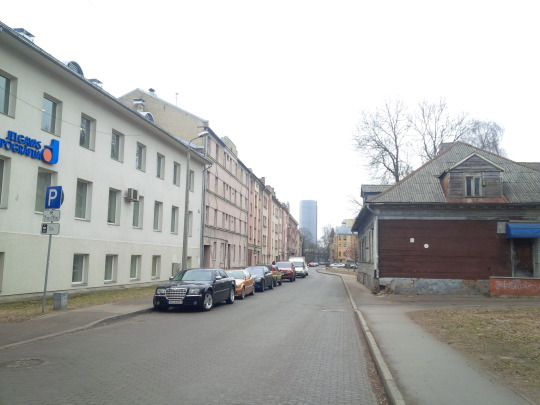
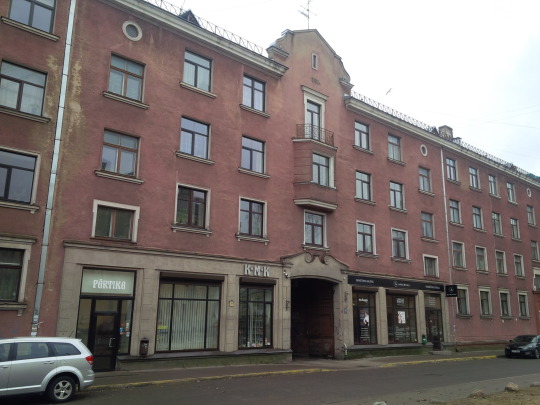
To our right there was a building which Konstantin pointed out was built on top of what had previously been part of Staraja Rusas iela, one of the only remaining streets in the city with a Russian name. While it's no longer officially part of that road (at least according to Google maps), it was interesting to see that some history-conscious person had written the name of the street above the driveway to preserve its memory. We also passed a what seemed to be somewhat nightmarish pre-school/kindergarten, along with a fairly scary balcony.



We came to the end of Valgumu iela, and before turning right onto Trijādības iela, we saw what Konstantin said had been a riverboat repair facility before being abandoned. We walked down Trijādības iela towards the river, seeing on our right a typical back yard with trees benches that are very commonly seen next to buildings built in the first half of the 20th century all the way up until the end of Stalin's time. A graffiti ghost on the wall seemed worried or upset about something; maybe we had gotten too close...



Unforunately we couldn't get any closer to the river since the construction area we had seen from AB Dambis was gated off, but Konstantin pointed out one very interesting building before we left. I wouldn't have noticed it on my own, but the two-story house was built in the traditional Latvian style that can be seen throughout the countryside, with the roof slanting on all four sides. Generally these houses are made of wood, so it was a bit unusual to see one here made of brick, further adding to my impression of Āgenskalns as one large architectural gallery. We passed by Latvia's sea administration and a modern apartment complex before coming again to the abandoned riverboat factory as well as a row of very typical brick hruščovkas and another scary-looking kindergarten.
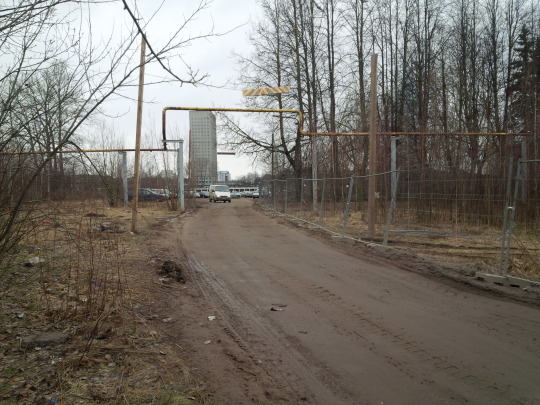



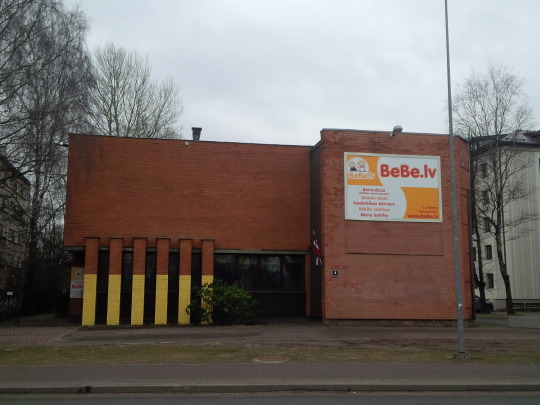
We took a right onto Raņķa dambis, which quickly turned into Daugavgrīvas iela. Although winter was more or less over, the cove of Zunds canal still had a thin layer of ice covering it. We got a good view of the old riverboat repair factory with some Latvian graffiti on the side and then saw some modern riverboats being repaired right in front of our eyes. Since there is no longer a dedicated facility, a man was standing on top doing some welding right in the open on the deck. We also passed my favorite place in Rīga to drink outisde during warm weather months, Piķis un Zēģele, a relatively cheap pub with a deck overlooking the water. If you're ever here in the summer months and love to sit back and relax outside with good, reasonably priced beer while watching boats go by, definitely check it out.



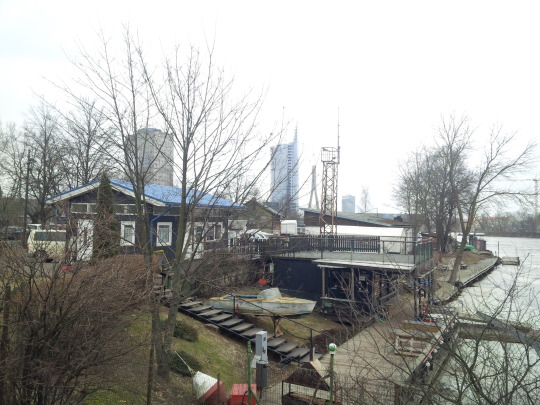
Just across Daugavgrīvas iela from the road to Ķīpsala, Konstantin pointed out a beautiful pre-war building which used to be a polyclinic for children and teens which unfortunately was now in such a state of disrepair that it had no floors. To the right was another beautiful pre-war building which was derelict aside from the first floor, this one having a commemorative plaque for Latvian composer Pēteris Barisons who had lived in the house before WWII. A brick hruščovka next door ws in much better condition, and had a variety of stores on the first floor including what looked like a tasty vegetarian restaurant.



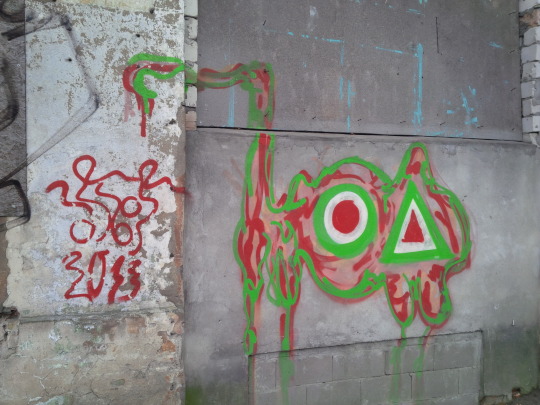

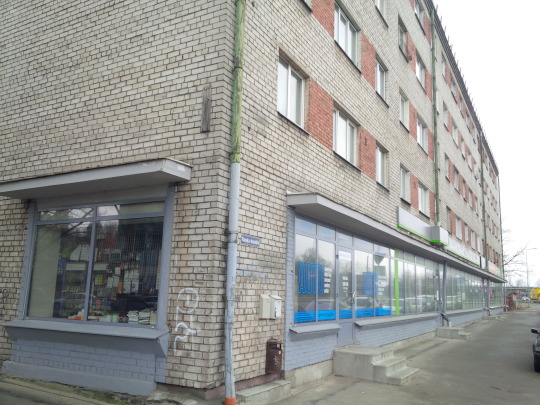

And now we were finally at the base of the infamous “Z-Towers” which had been visible from many previous neighborhoods. As I mentioned briefly in the article about Dzierciems, these troublesome twins had been under construction since 2006 and were conceived in a different era of urban planning just before the 2008 crisis where this area around Ķīpsala was planned to be a sort of financial district for the city and many other similar large buildings had been planned. As it is, it's almost a small miracle that these ones got finished at all. The buildings began sinking not long after construction since engineers had failed to compensate for the marshy ground beneath, and had to halt progress and improvise a new technique for drying out the foundation. The death of a construction worker whose harness tragically failed stopped progress for even longer, and the buildings went through multiple exterior and interior design revisions as it was being constructed to help make it more more economically feasible. As a result, the final minimalist and utterly generic result is a far-cry from the original gaudy and bombastic structure that was originally planned.
First planned to be an upscale hotel in one tower and offices in the other, now the majority of units in both towers have been marketed as luxury apartments of various sizes. Until 2014, it was possible to receive a five-year Latvian residence permit with full access to the EU and a path to citizenship for a property investment of as little as 70,000 Euros. Although parliament bumped that up to 250,000 Euro due to concerns about Latvia's property market being exploited as a massive money-laundering mechanism by international criminals, I'm sure that foreigners with an interest in accessing the European common market should have no problem finding a unit worth a quarter of a million in these glass behemoths. On one hand these towers further justify Āgenskalns' reputation as an architectural mecca, but at the same time even for this neighborhood they stick out like Siskel and Ebert's thumbs banged with a hammer by a bitter director. While it's easy to dismiss them as yet another tacky monument to the anonymous global 1%, I like to think of them as a relic from a more optimistic time in the city's history when the sky seemed the literal limit for ambitious developers just before it fell in spectacular fashion just a short time later. For more information about the history and future of this ongoing saga, check out this incredible thread on skyscrapercity.com which has been documenting the building's progress over the past ten years.
When we tried to get up close to the buildings, a security guard at the gate predictably banged on the glass and yelled at us to get lost. We were still able to get a nice look at the impressive structures as we hung left onto Krišjāņa Valdemāra iela and started up the hill towards the northern part of the neighborhood.

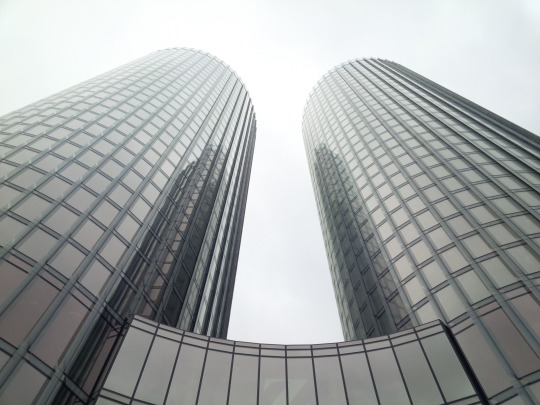
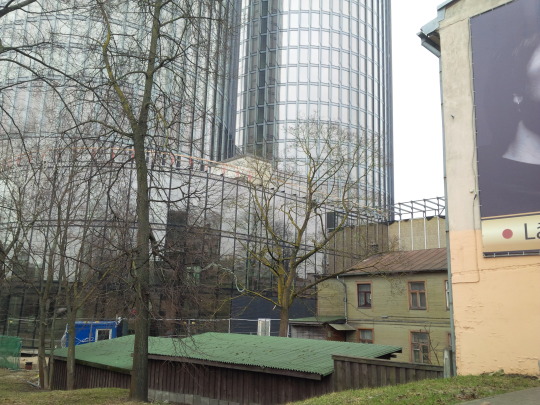
While the same can be observed in pretty much all of the city's more central neighborhoods, the clash between “old” and “new” is especially striking here. Aside from the obvious example of Z-Towers, this street was lined by a mix of small pre-war wooden houses, concrete and plaster early 20th century buildings, and glass and steel constructions which look like they had been dropped off by a visiting UFO.



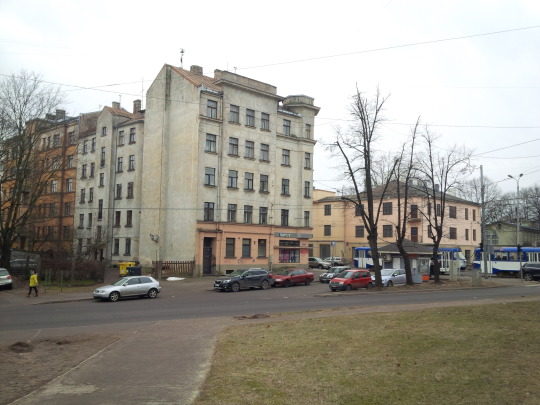

So far, this had been our route since we had met Līga near the library:

We now started down the major thoroughfare of Slokas iela, coming up close to one of Konstantin's and my favorite looking buildings in the city: the national historical archives. I'll let the pictures speak for themselves in terms of how awesome this building looks. The archives are free to browse, but professional photocopies to be brought home cost a fee. Luckily, scores of benevolent history fans have uploaded a lot of material contained there for free to various forums and websites. Much of the information contained there is in Russian due to that being the lingua franca and official language of the Soviet Union, so proficiency is required for serious browsing/research. Documents from 1920-40 though are mostly all in Latvian.
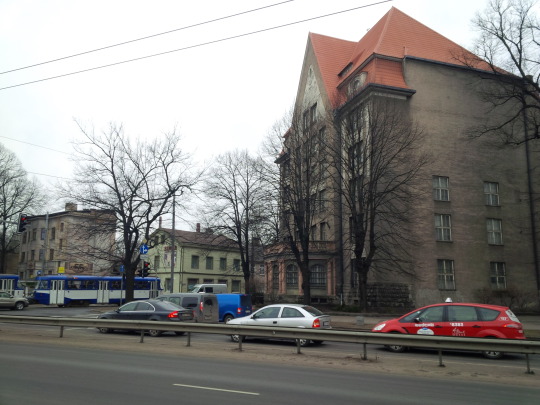
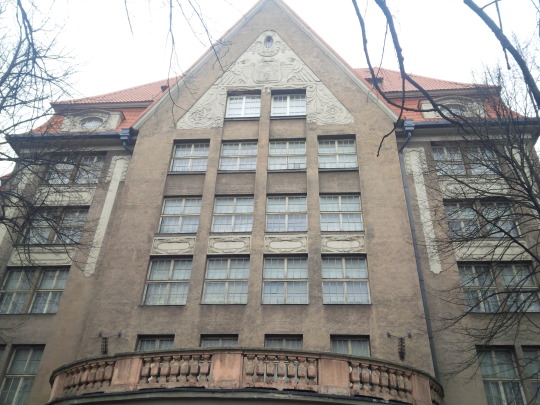

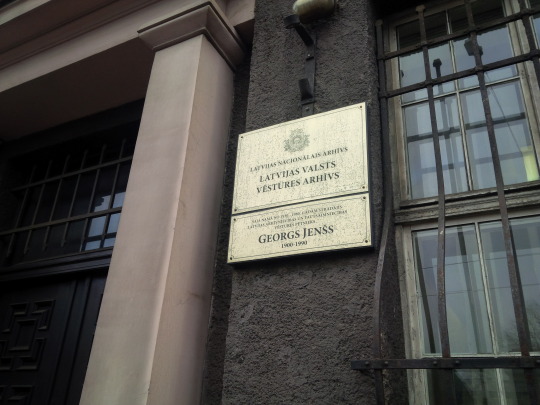

Slokas iela contained a nice mix of older wooden houses and Rīga's famous art nouveau buildings from the early 20th century. On one of the buildings, we found a subtle but interesting historical relic. During Soviet times, all of the street names were written in both Latvian and Russian throughout the city. After regaining independence, the government began replacing them with newer, Latvian-only plaques. On this particular building instead of replacing the entire sign, someone simply painted over the Russian version of the signage which had been found on the bottom of the sign. The result was surprisingly effective, as I never would have noticed if Konstantin hadn't pointed it out to me. We walked left down Mārtiņa iela and then left down the offshoot of Daugavgrīvas iela. No matter how far we walked away from them, Z-Towers loomed behind us.
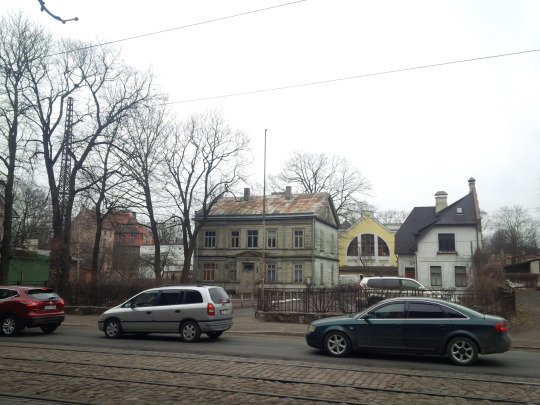
Jugenstils (art nouveau)
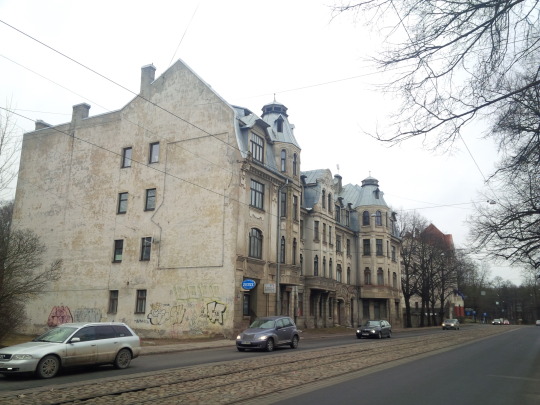

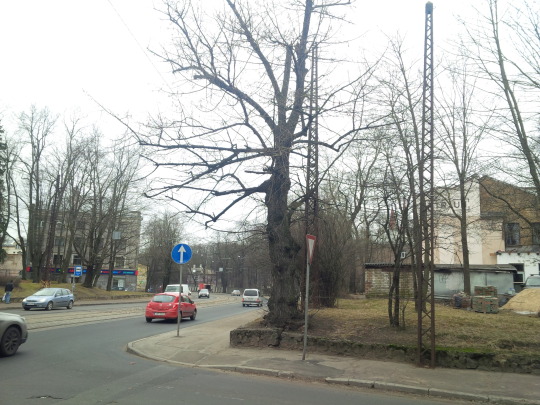
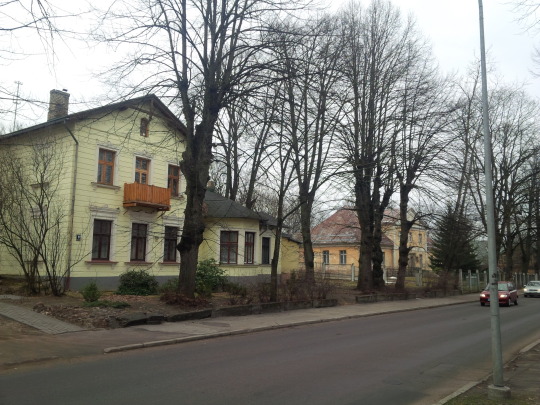

And now we came up to one of my many weird civil planning-related obsessions: a ghost ramp! These “roads to nowhere” are offshoots of other roads that are built to connect with a future transportation project that for one reason or another never quite materializes. This particular one was intended to connect with one of the many aforementioned projects intended for the Ķīpsala area before the bubble burst in 2008. If Z-Towers are a semi-living monument to the pre-crash era of naive optimism and big thinking, then this ramp is something like a poignant and symbolic memorial. I was excited to finally have an excuse to go onto this ramp that I had passed so many times before on my way to work, and from it we had a nice view of the tall buildings as well as the former territory of a factory that built farm machinery just underneath where the ramp is now. We also got a view of the northern edge of Āgenskalns where we were headed next.
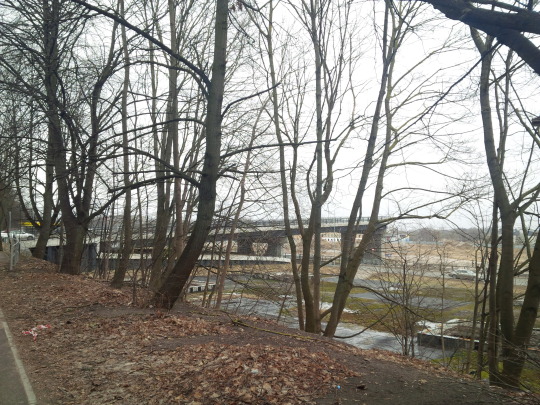
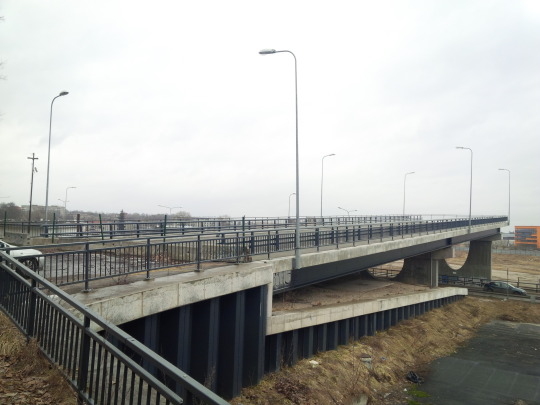
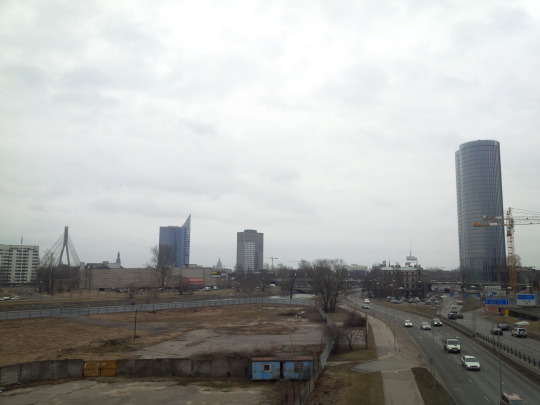

We walked towards Mārtiņa Evaņģēliski luteriskā baznīca (St. Martin's Church), passing two older art nouveau buildings: a current police station to the left, and an apartment complex with a classical-style sculpture out front to the right. When we got to the church's back yard, we took the path through crossing back to Slokas iela. The Romanesque church was built in 1851 and 1852, and the red twin steeples are visible from most of the northern part of the neighborhood. Konstantin pointed out the odd fact that the lantern is built in such a way that it can be lowered using a pulley.
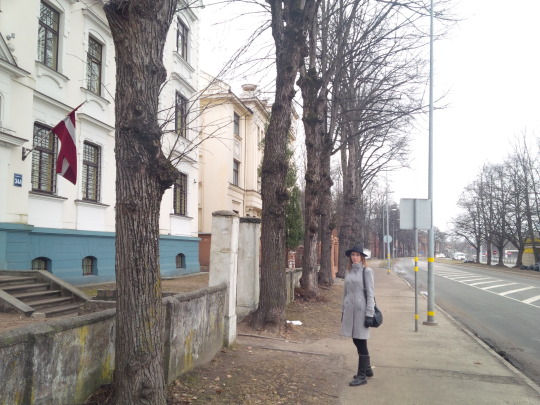
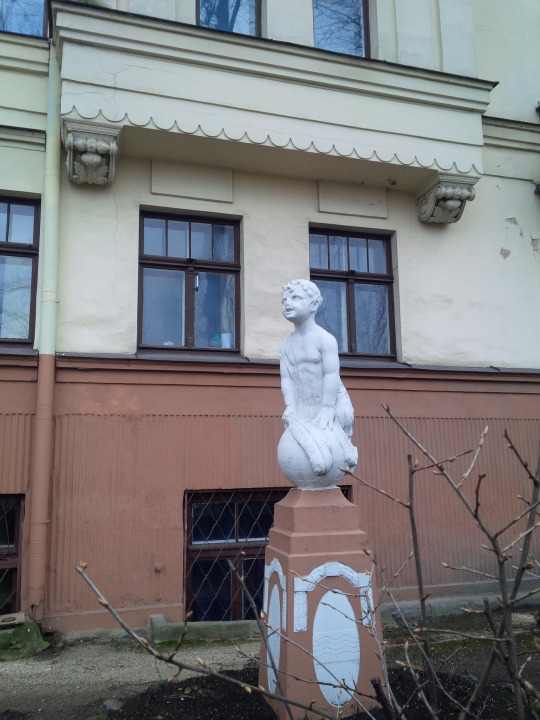
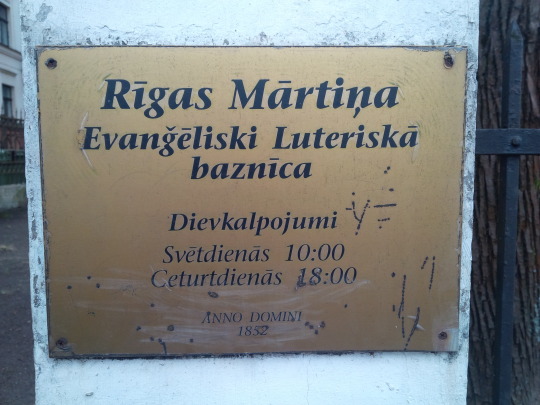


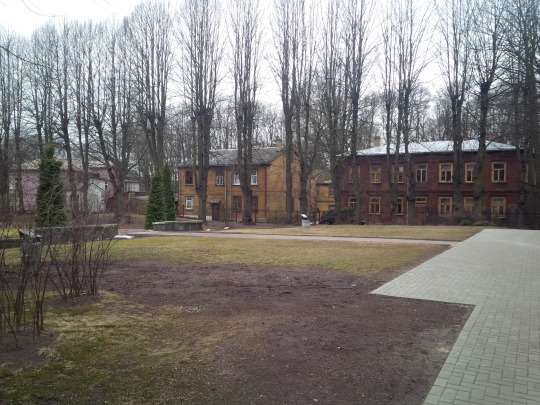
lowerable lamp

Coming out of the church yard and turning left onto Slokas iela, we passed a cool purple wooden building and a music school before coming to the nearly-abandoned Mārtiņa kapi (St. Martin's Cemetery). Many of those resting in this graveyard have no living relatives to maintain their graves, although we could see a few modern tombstones that distant descendants had bought for their long-departed ancestors. Following the tram line down the street we also passed the very modern purple courthouse before we turned right down Kuldīgas iela.
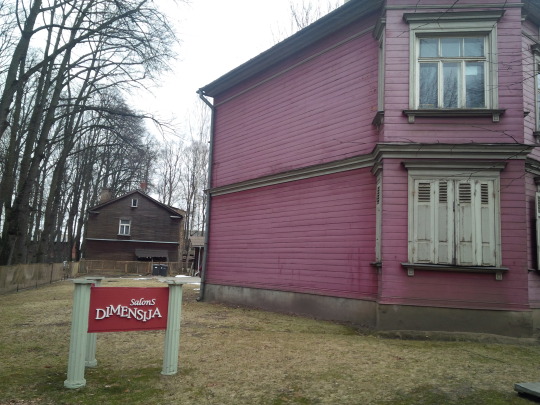

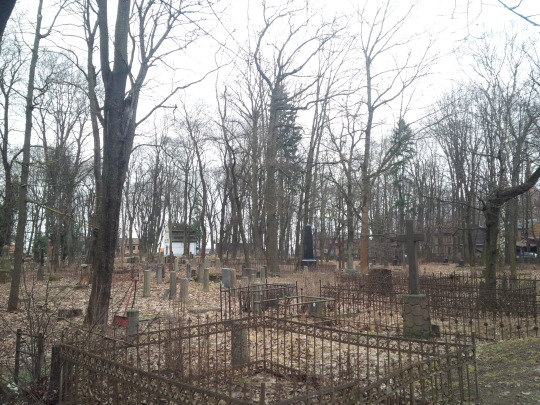
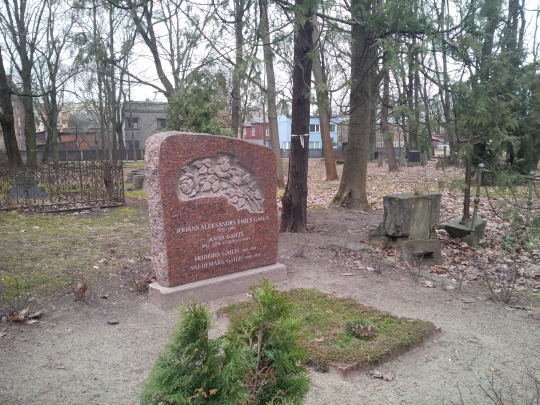


Just as we were turning left down Kuldīgas iela, we saw a plot of land adjacent to the botanical garden that seemed like it was part of the garden's territory until Konstantin explained that it was actually a private plot in the process of being sold. That explained why it had the old-fashioned wooden fence while the rest of the garden had a much newer metal one surrounding it. Signs of spring were everywhere as we continued down the street; people were raking up leftover leaves now that the snow had almost all melted, and small flowers were starting to bloom here and there. When we came to busy Vilpa iela, we turned left and came to Rīgas Valsts vācu ģimnāzija (State German Gymnasium), one of the city's oldest high schools founded in 1921. During months when leaves are on the trees, the school is hidden from the road except for the wooden “window” which you can see in the first picture of the school. Unfortunately, at this time of year the effect gets lost.
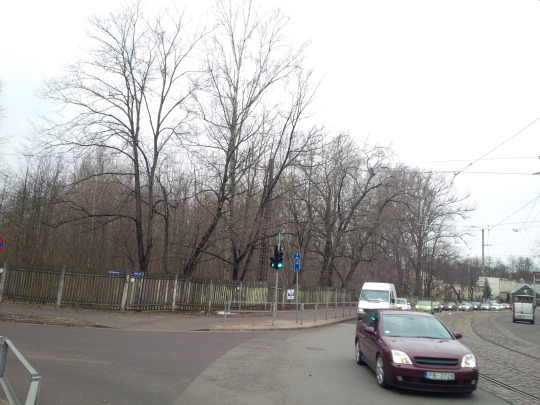
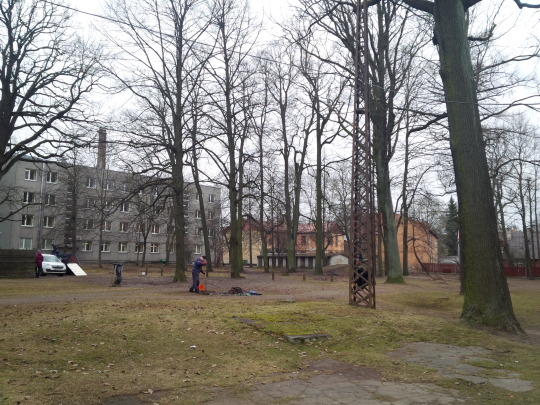
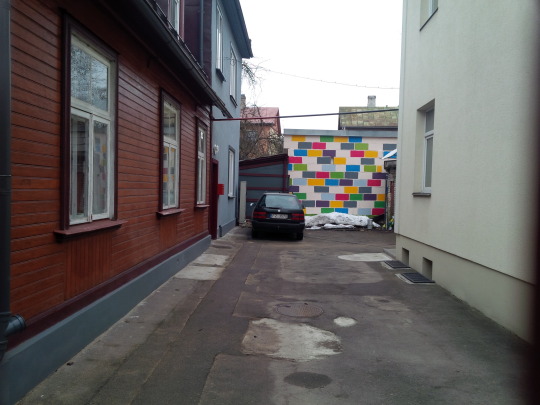
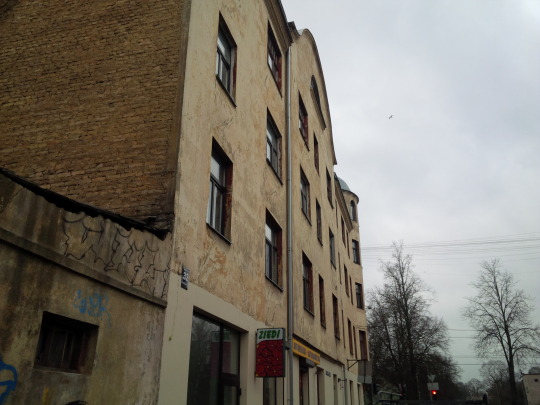
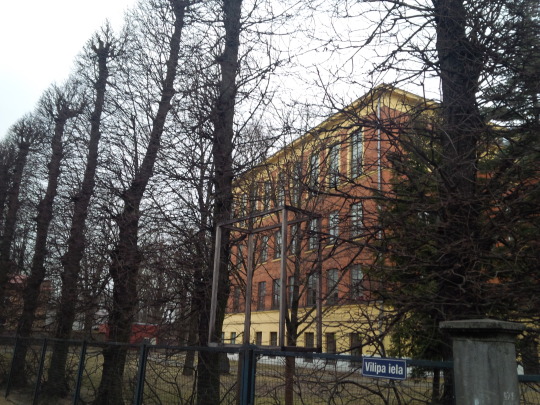
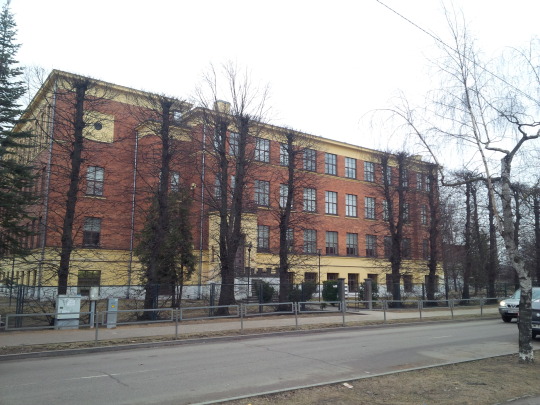
At the corner of Melnsila and Āgenskalna ielas, we found what Konstantin explained was called “Āgenskalna Priedes” (Agenskalns Pines). This early and experimental “micro-district” that the Soviets constructed in the late 1950s was the first of many often much larger projects in the further-out neighborhoods of the city which were constructed all the way through the 1980s. These concrete-panel buildings are some of the first very early hruščovkas to be built in the city in response to the post-war housing crisis that was only exacerbated by Stalin's obsession with ornate, decorative buildings which took too long to construct to meet the population's needs. Konstantin told us that while these buildings look to be in good condition from the outside, many have problems with electrical wiring beneath the floors that were not properly installed during the original construction.
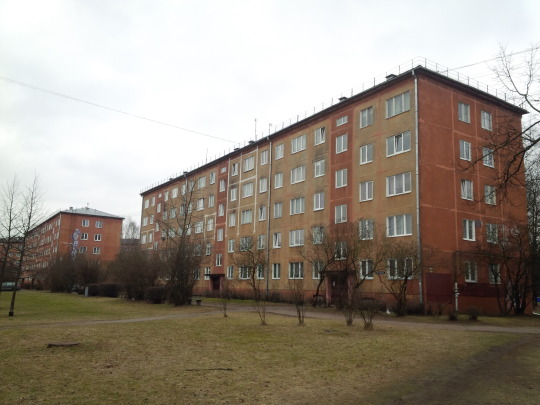



This housing project also has one of the last Soviet-era playgrounds to not be torn down to to safety concerns. The metal playground equipment you can see used to be ubiquitous throughout the city's suburban districts, but since independence the city has mostly favored removal over renovation. The building you can see in the background looks new, but is actually a recent renovation of a pre-war building. Seeing the potential of what could be if more of the city's gorgeous old structures received the same love and attention only makes it sadder to think about many of the other buildings' current states.

From the background of the development we could finally get a great view of one of the neighborhood's most famous landmarks: the water tower named “Alise” Yes, believe it or not, some of the city's gorgeous water towers have these kinds of names. After this particular one stopped being used for its original purpose due to introduction of more modern distribution methods, the building was used as an underground record label/studio until the late-2000s. The owner of the Coffee Tower chain and a few other bidders tried to buy it, but the city deemed it a historical monument before it could fall into private ownership. Hopeful the city will maintain and find a good municipal use for this beautiful landmark, as the building really is a stunning piece of architecture.
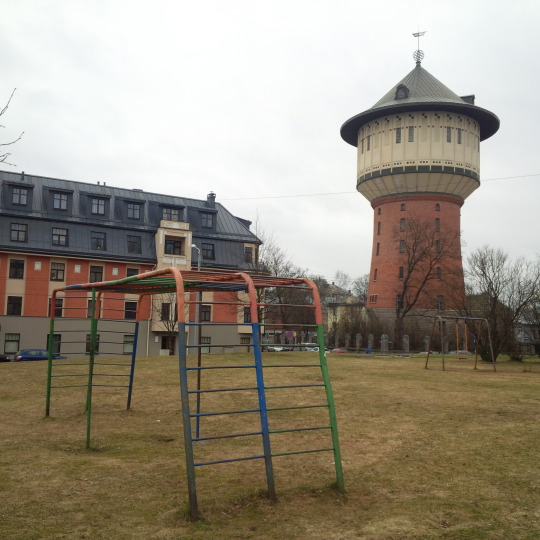

We turned back onto Melnsila iela and passed a wooden building with a store called “Alus pagrabiņš” (which translates to something like “Little Beer Basement”), a store which sells unusual and hard-to-find beers both on tap and in bottles. People often buy large plastic bottles of the beer straight from the tap so that they can bring it home and drink later, which is usually cheeper than buying glass bottles or cans.
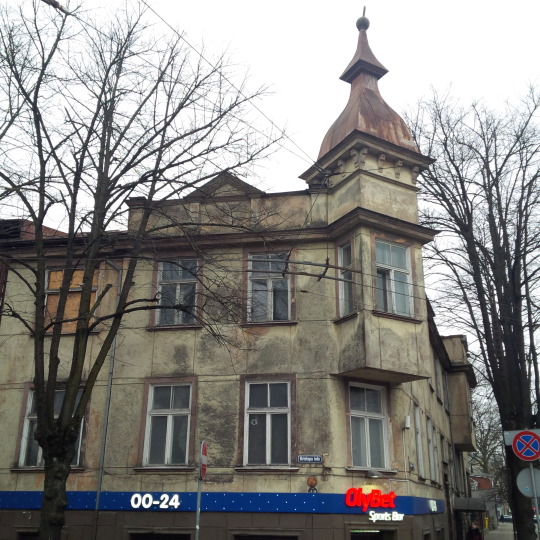

Now we came to the famous “Kalnviema kvartāls” (Kalnciema Quarter), a group of wooden buildings on the corner of Mensila and Kalnciema ielas. One of the most well-known enclaves of the city's “creative class,” the mini-district features various shops, galleries, offices, and performances spaces, and hosts many cultural events including a weekly Saturday market in the main yard between the buildings. We regretted not being able to come here a day later to check out the market, but I would strongly encourage visiting it if you can make it out here on a Saturday. For any of you who are fans of good wine, there's also a fantastic wine shop and cafe open every day except Sunday from 10-22.
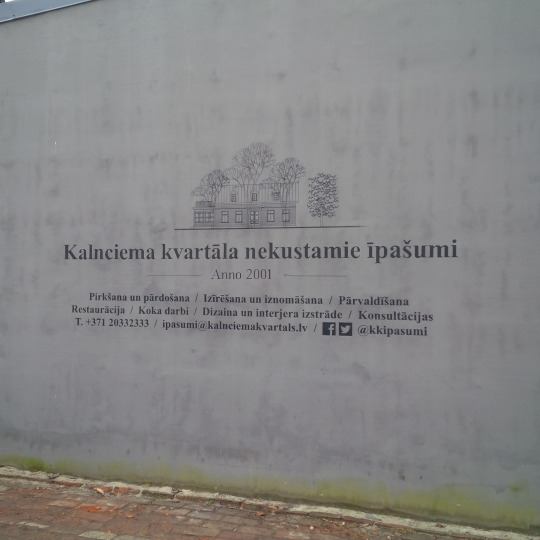
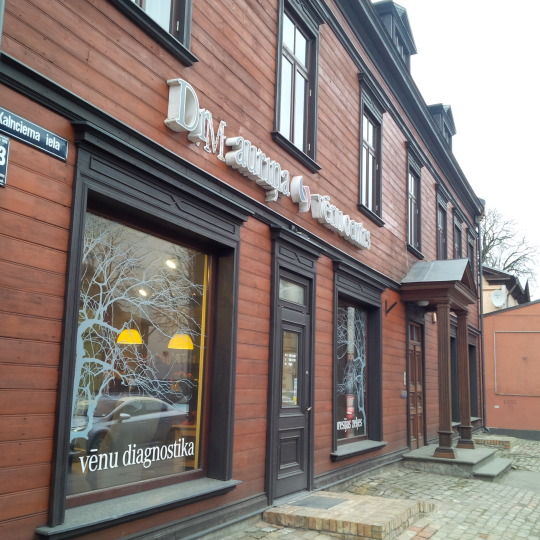

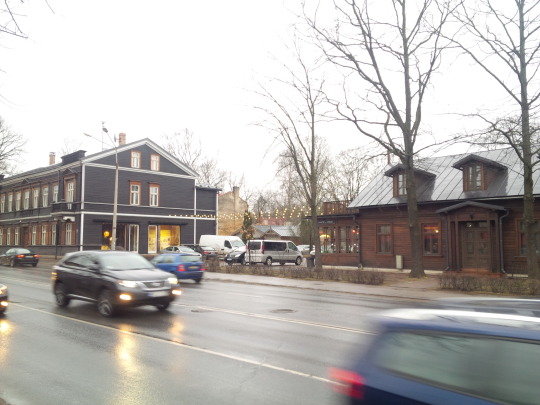
We were pretty hungry at this point, so Konstantin suggested that we try a kebab place called “Fix Box” which he had passed many times before but never actually tried. The interior was modern and colorful, and the prices seemed fairly reasonable so we decided to give it a shot. The wrap was toasted and crispy, which was a bit unusual for Riga's kebab places as they usually wrap them in softer shells. Overall the kebabs were pretty good, but I'm not sure it was mind-blowing enough to recommend coming all the way from the center for considering the wealth of options there to try. If you're in the area and love kebabs though, I doubt you'll be disappointed.
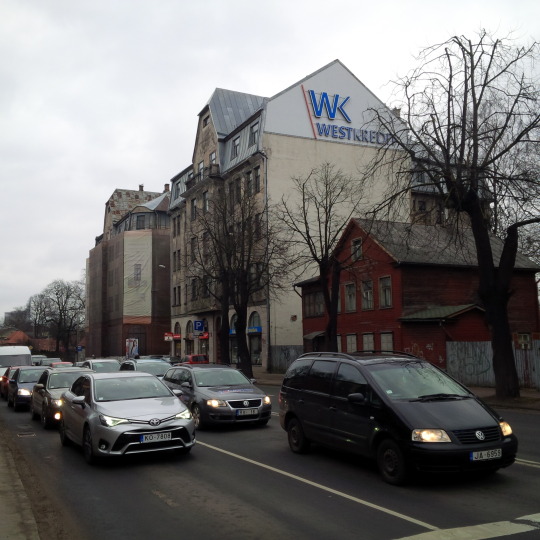

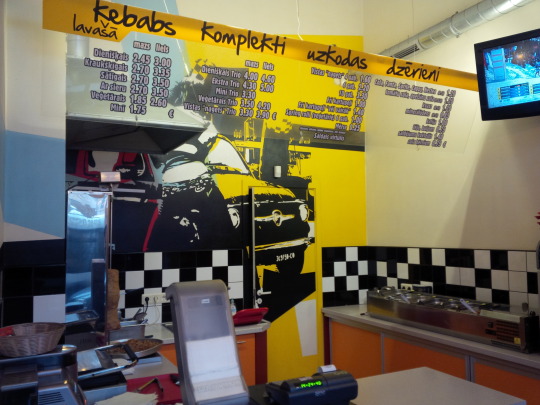

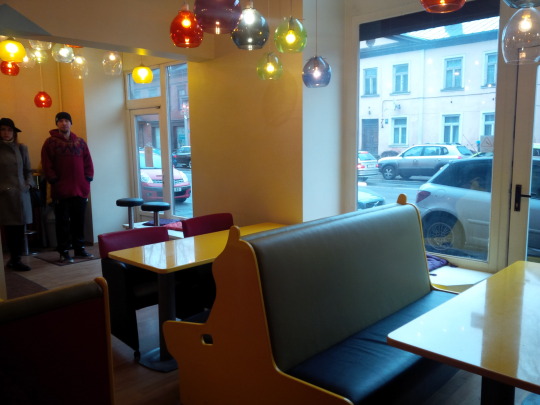

Since the ghost ramp, here is more or less the path that we had taken to the kebab spot:

As we left our lunch place, the weather began to take a turn for the worse that would gradually only worsen. Undeterred, we continued southwest down Kalnciema iela before hanging right onto Sabiles iela. Down this street the mishmash of modern and older architectural styles continued, although in this part of Āgenskalns most all of the buildings didn't reach more than three stories tall. Konstantin pointed out that the dilapidated green building at the end of the road had been “somewhat renovated” on the very right side, which is not uncommon for some of Riga's older buildings in such condition considering that many such buildings have multiple owners. A lot of the older wooden houses throughout the city are split into halves or even quarters depending on the size, and this can be reflected sometimes in the buildings' visual appearance.
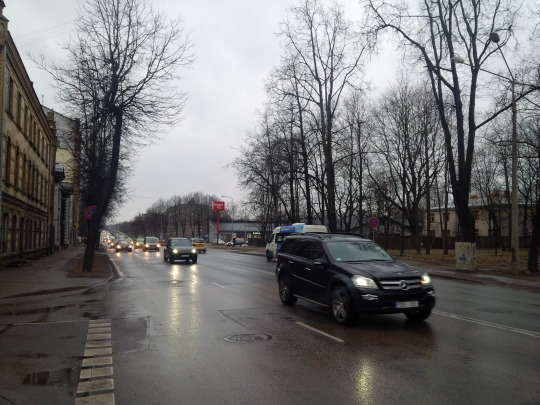
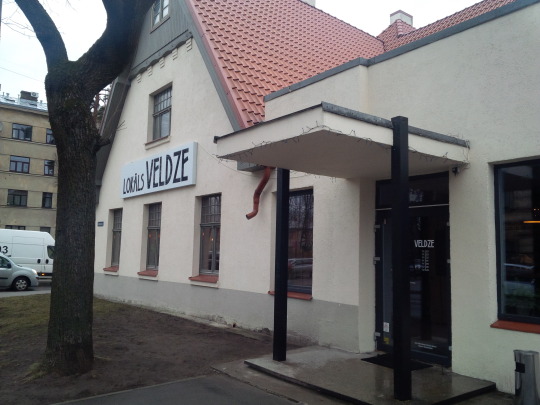


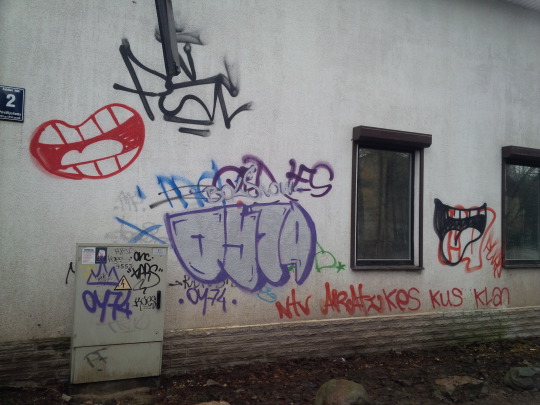

At this point, Sabiles iela turned into Talsu iela, and we continued on towards the more urban part of Āgenskalns. Right at the start of Talsu iela I saw one of the coolest yet strangest-looking houses I've ever seen, which seemed as if the architect was torn between three different styles and chose all three. A bit further down the road, we got a glimpse at the old TV tower. Before moving to is current headquarters on Lucavsala in the middle of the Daugava, Latvia's Television used to be headquartered in Āgenskalns, and used this tower to broadcast. According to Konstantin, the city has deemed the tower as a “dangerous object” and has ordered it to be repaired immediately. Regardless of its perilous state of repair, the tower still currently broadcasts Radio Merkurs on 1485 kHz (AM).


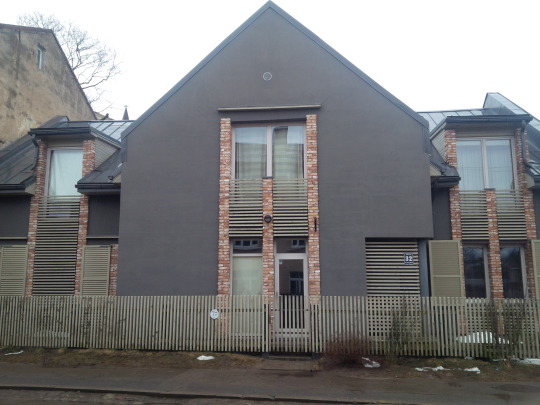


We turned now left onto Nometņu iela since Konstantin wanted to show us a few different buildings this way. We found a sad wall that was either bemoaning street litter or had very low self esteem. A bit further down we came to the first of the buildings that Konstantin had mentioned, a “communebar” called “Hāgenskalna Komūna.” He told us that it's the best place this side of the river to hear small acoustic concerts, although various DJs also play sets. Apparently they also offer a good selection of food and drinks, so we plan to check it out sometime soon.
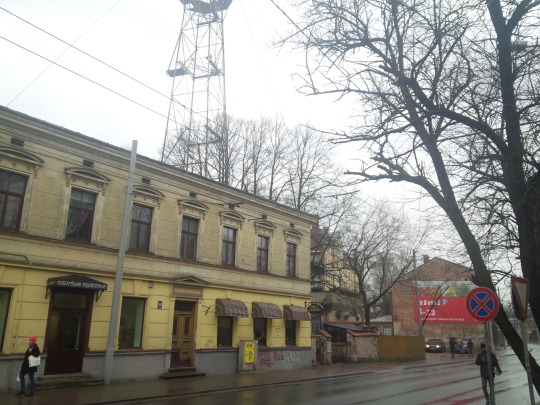
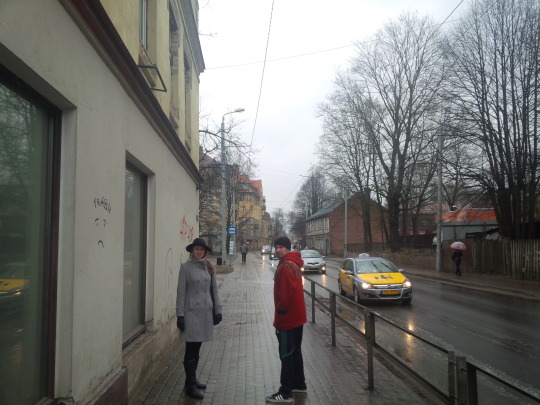

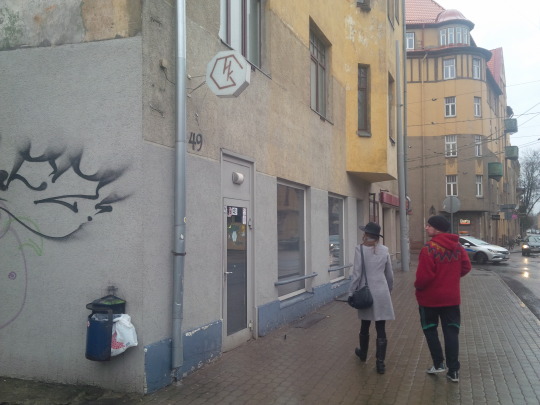

Just past the corner of Lapu and Nomeņtu ielas we came across the scariest-looking balconies on the planet, which were all missing floors. They were (barely) attached to one of the coolest-looking buildings in the entire neighborhood, a strange castle-shaped one over which there is a dispute as to which architect designed it. Apparently two people claimed to have drawn the original design. Next we found what is a very popular trend in America but something I had so far yet to have seen in Latvia: former cinemas converted into evangelical churches. The first was a brown Art Deco-ish one on the left which now hosts the “Dzīvā Ūdens Avots” (living water source) Pentecostal Church, and the second was a tan-colored one just down the street which is inhabited by the “Jēzus ir Kungs” (Jesus is Lord) evangelical church. The second was offering an “alpha course,” a basic introduction to Christianity that was popularized in the UK but can now be found all over the world.
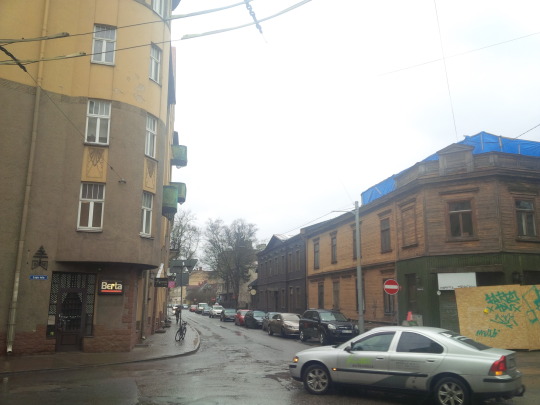
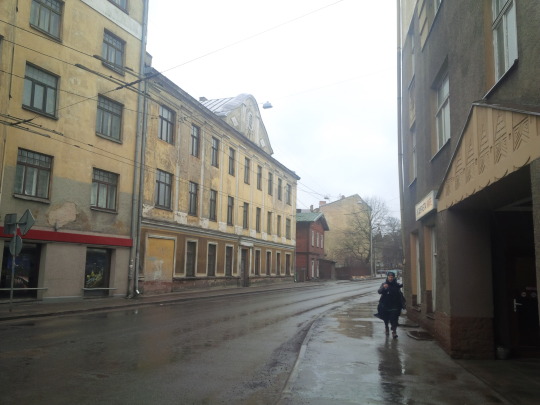



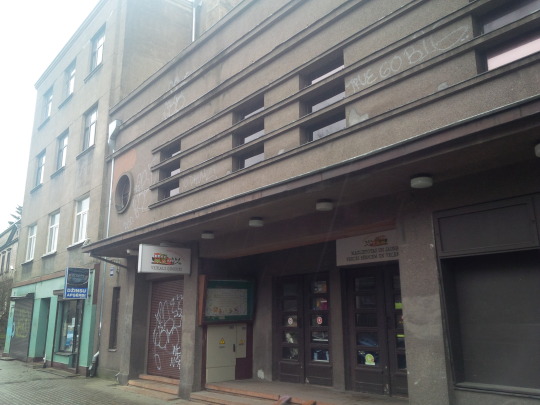


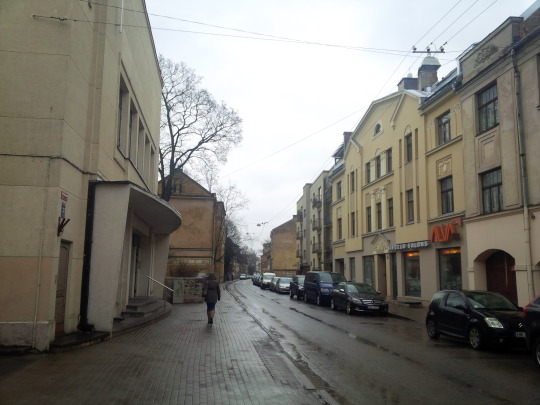
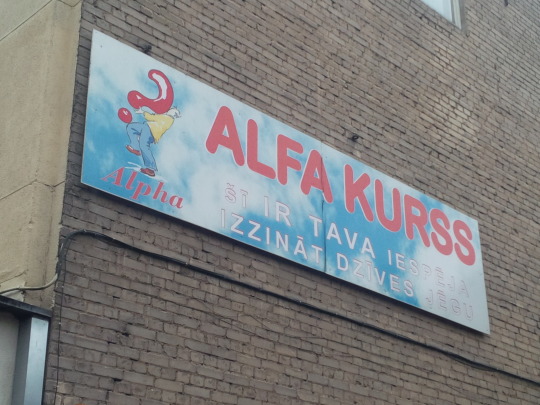
Continuing down the street, we saw more wooden and brick buildings from various eras. Shops included a fancy-sounding “brick salon” (yes, a salon in which you buy bricks), a door and window ship, a pizza place, an upscale restaurant, an antique shop, and another location of one of Līga and my favorite cafes in the city: Ciemakuklis, which we visited in Dzirciems last year. At the intersection with Slokas iela we took a left.
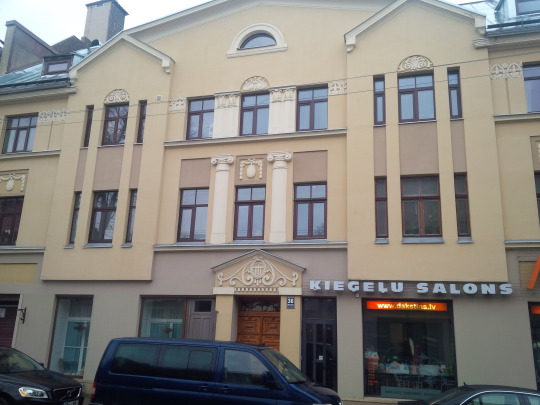
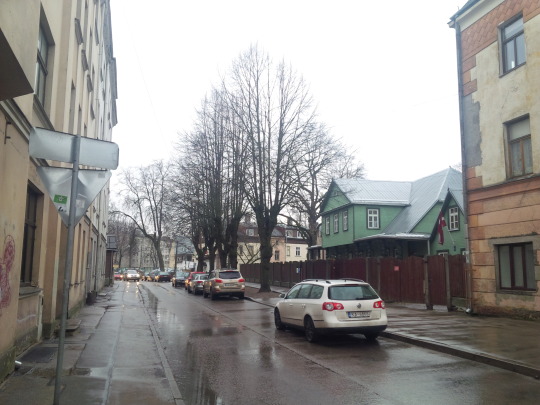

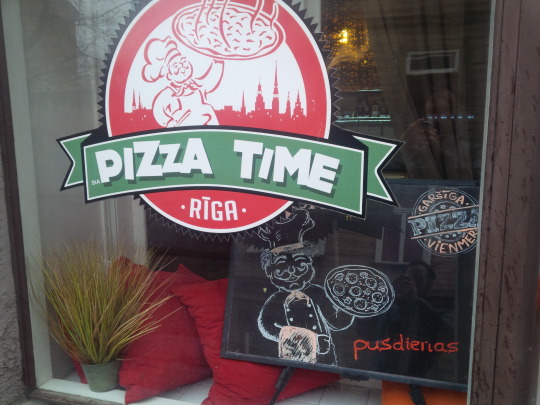

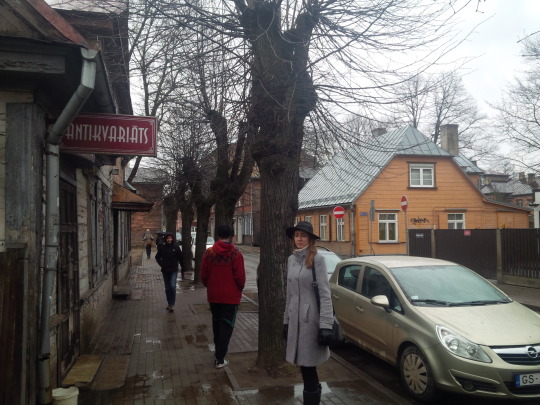
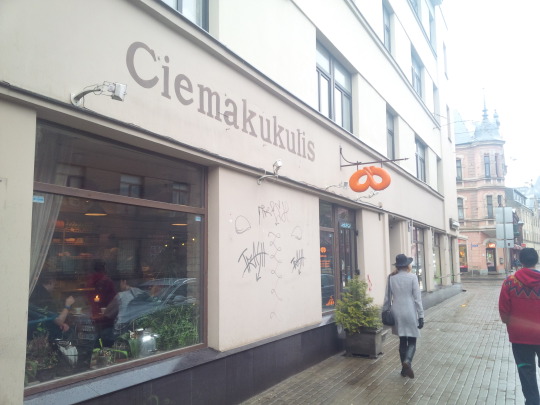

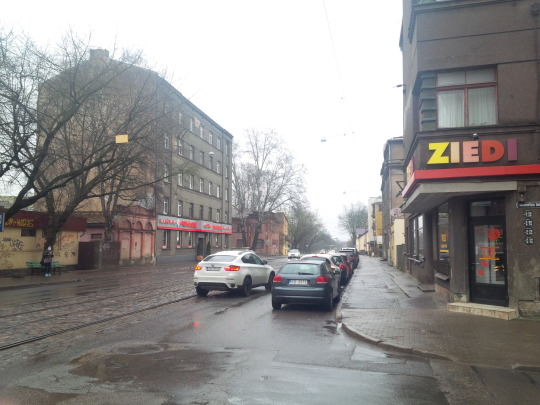
On Slokas iela, Z-Towers once again reappeared and loomed in the distance. We walked first by a church called Latvijas apvienotā metodistu baznīca (Latvian United Methodist Church), one of the few methodist churches in the country. Next door was an old white building which Konstantin said used to be used as a wedding registry. He told us that his parents had registered their marriage there, and that they were sad to see it become derelict throughout the years. We were just about at the corner of Slokas and Kalnciema iela again where the state archive was, so we took a few pictures and then hung left down Ernestīnes iela back towards the market square.

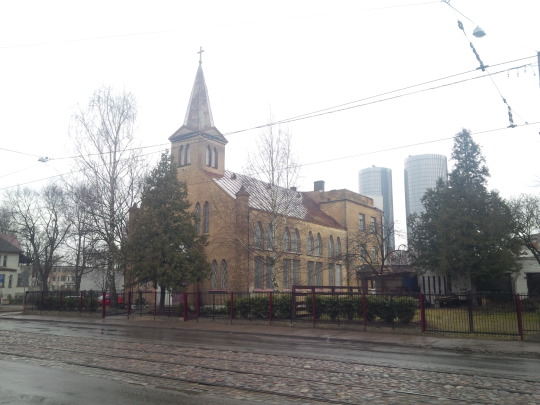



Ernistines iela cut through yet another district of short, wooden houses, but this part of town contained some of the city's most well-known schools. The first was Rīgas Dabaszinību skola (Riga School of Natural Science), a UNESCO-affiliated youth education center that puts on various workshops and activities related to natural science. The gate looked open and we wanted to take a look through the school's grounds, but we opted against it. Across the street was the well-regarded Āgenskalna Valsts ģimnāzija (Agenskalns State Gymnasium), a high school that is consistently ranked in the country's top five in terms of exam results and student achievement. The third we passed was the newly renovated Rīgas 53. vidusskola right on the corner of Ernestine and Melnsila ielas.



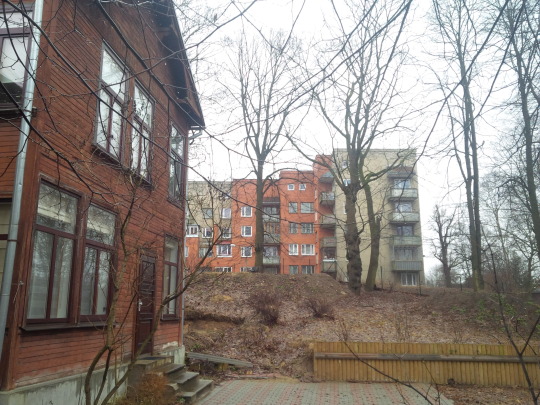
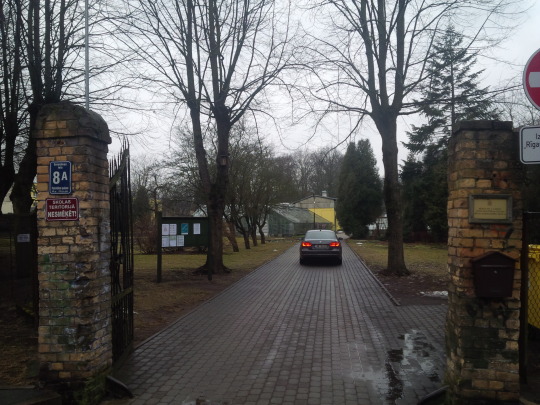
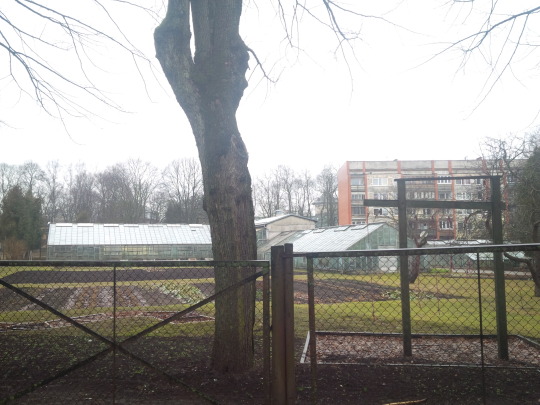
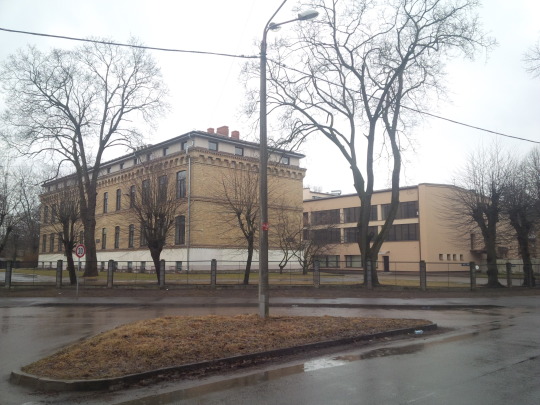


As we turned left back onto the larger road, we saw a car driving by with some large metal piping tied dubiously onto the roof. This reminded me of how in my home state of Maine it’s not uncommon to see pickup trucks on the highway with large stacks of various items tied precariously onto the bed, and how its occasionally necessary to dodge them when they fall out onto the road in front of you. We followed Melnsila diela back down to Nometņu iela where we took a right and started heading toward the market.
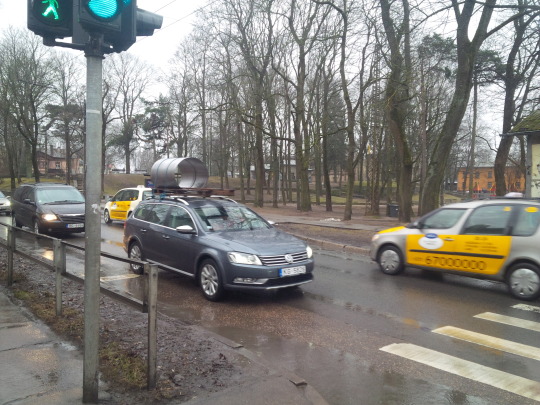
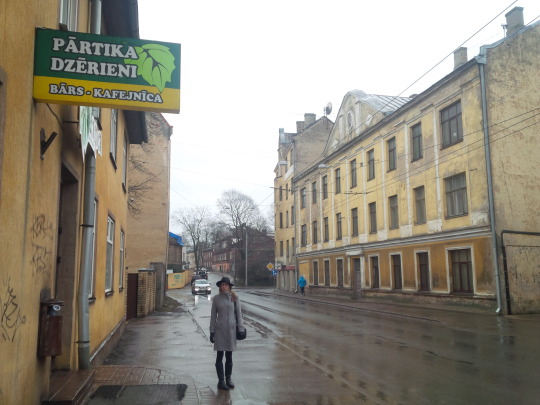
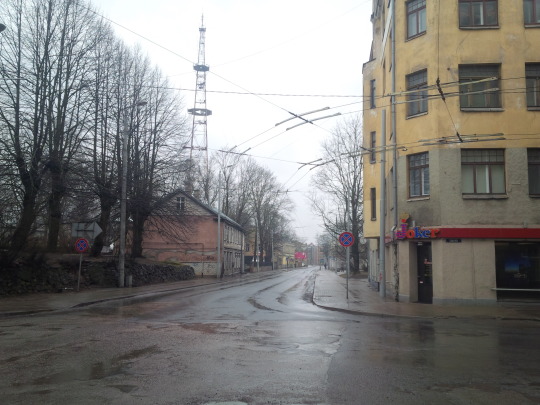
Since leaving the kebab spot, we had walked in this very strange spiral-shaped path:

On our way to the market we passed by one of the city's rare food trucks as well as two cafes situated next to the old tower. It's a bit hard to see from the picture, but one of the tower's supporting guy wires had been decorated with colorful ropes. Konstantin told us that the SEB building (one of Latvia's most popular banks) used to be taller, but that the top floor had been removed during renovation to help make the building more sturdy.
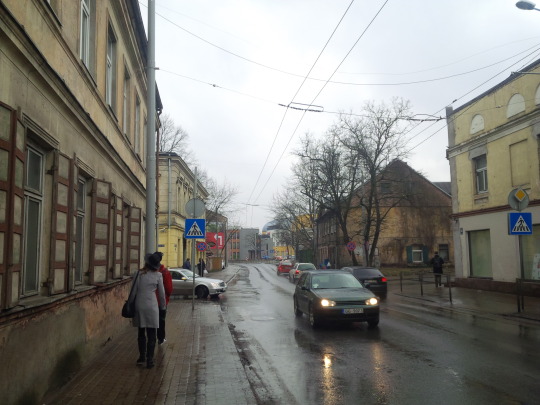




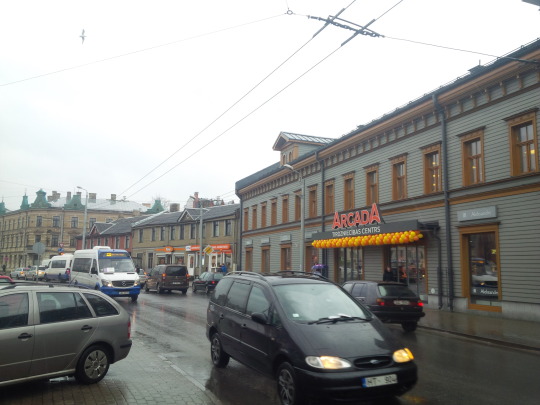
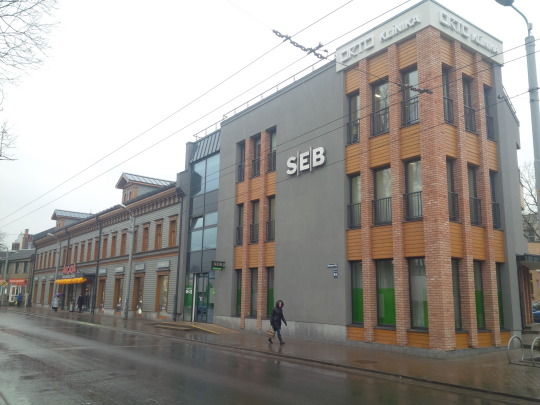
In the market square there were a bunch of posters for a theater event called “Obama Bananas Go,” which according to one of my friends was some sort of abstract high-concept comedy show that had nothing whatsoever to do with former President Obama. While I was shocked at first and am sure that the poster would have not only been taken down within hours but also sparked outrage if it were posted in the United States, Latvia has so few people of color that conversations about race are nearly non-existent and some of my students even have a hard time understanding why they can't use the n-word even though they hear it often in rap music. That doesn't stop me from trying to educate my students about these issues as much as possible and doing my small part in improving this situation, but I'm not as shocked by this sort of thing as much as I was when I first came here.
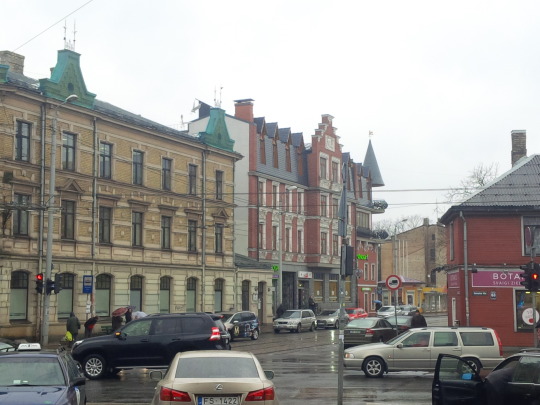
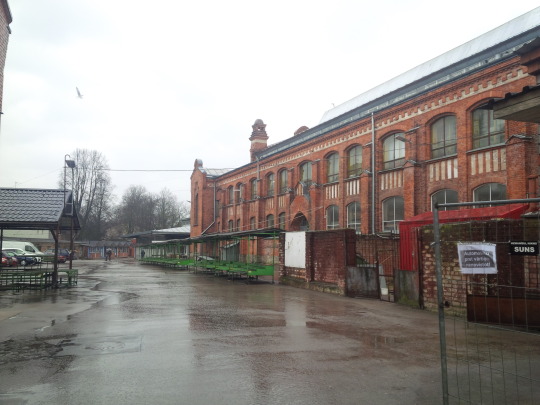
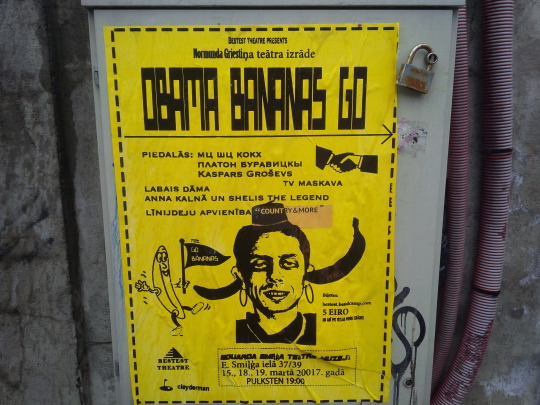
This “trash” frowny face was even sadder than the last one.
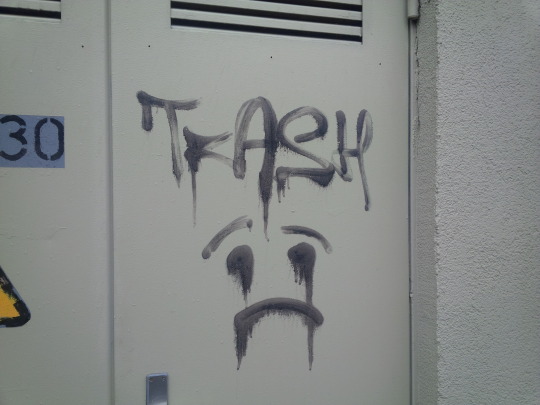
The interior of the market building was fairly typical for this region of Europe, but Konstantin told me that he much preferred this one to the more famous and impressive central market in Rīga's center due to its more intimate feel. The walls above the market stands were adorned with the coats of arms of Latvia's cities and towns, which was a nice touch. Luckily the upstairs balcony was open and we were able to get a nice view of the whole inside. There were some very nice looking meats, fruits, and vegetables, but we still had a lot to see and decided that carrying around perishables probably was not the best idea.


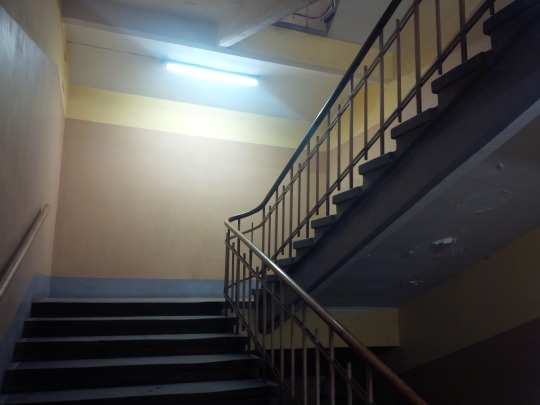

The stands and benches outside were emptier than usual due to the weather, but there were still a few people selling fresh flowers to passers-by. We continued a tiny bit further down Bāriņu iela to one location I had passed by many times but had never been able to get a closer look at: the Eduarda Smiļģa Teātra muzejs, the city's museum of theater. This former home of famed actor and director Eduards Smiļģis (1886-1966) is now run by the Latvian Academy of Culture as a space for exhibitions and live shows. The grounds of the building were gorgeous, but unfortunately we decided that we would have to save the museum itself for another day considering how wet we now were and how little time we had left to see the rest of the neighborhood.



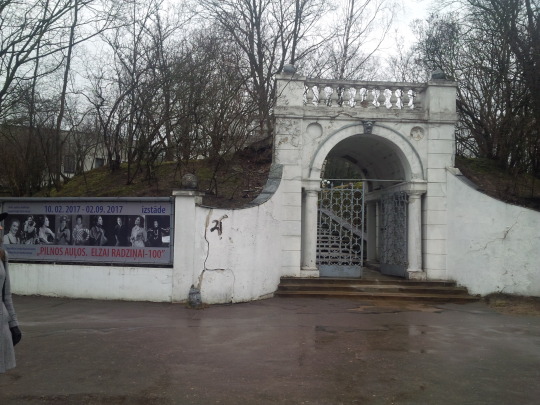




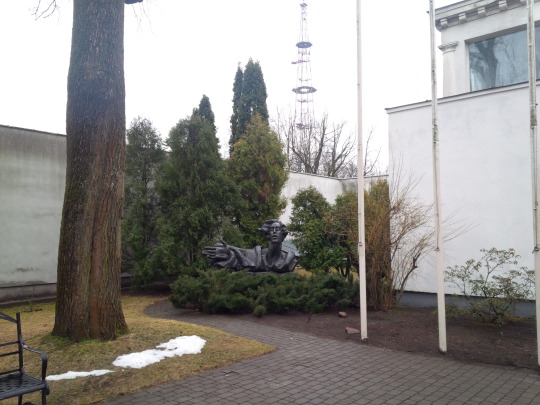
Līga wanted to see Svētā Alberta (St. Albert's), one of her favorite churches, so we headed towards it via a roundabout route past Māras diķis (Mara's pond). We started past the beautifully painted Rīgas Friča Brīvzemnieka pamatskola, one of the city's most historic elementary schools. The far less attractive concrete box across the street was Rīgas Pārdaugavas izpilddirekcija, home to a variety of government services available to those living on this side of the river. This style of building which looks brutalist to American or British eyes is incredibly common throughout the former Soviet Union for various municipal or education-related institutions. As we got closer to the park, we passed a few more wooden and brick buildings built before WWII as well as a few very modern constructions.

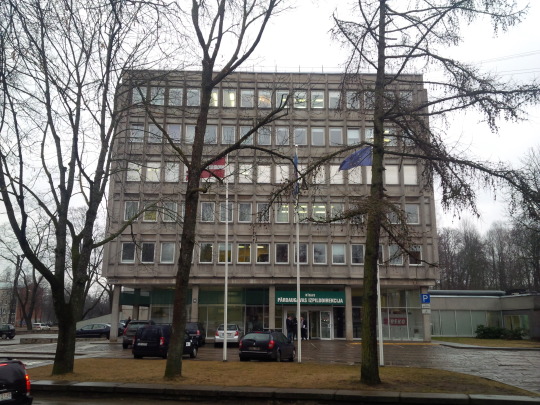


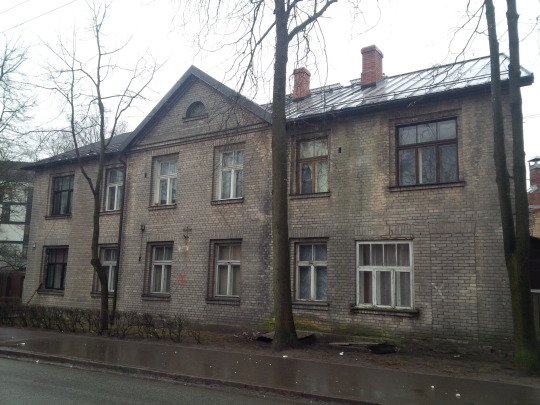


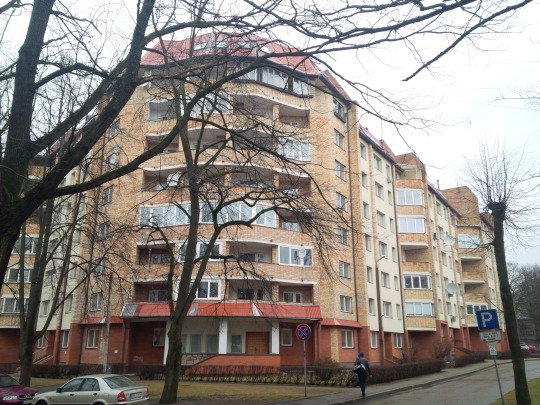
Right near the pond there was a small park with a hill formed from a split between Kokles iela and Mazā Nometņu iela. There wasn't any information that we could find about it, but it seemed like a natural extension of Arkādijas parks in Torņakalns on the other side of the road. The park seemed pretty well-maintained, and at the top of the hill there was a decent view of the surrounding area including the pond.





As you can see from the last picture, Māras diķis is lined on its eastern coast by a walled-off mansions. Thankfully, the entire circumference of the pond is accessible via a paved walking trail. The pond was used for mills all the way back to the 13th century, although the most recent mill was torn down in the 1920s. These days it's only used for recreational purposes, but no swimming is allowed.

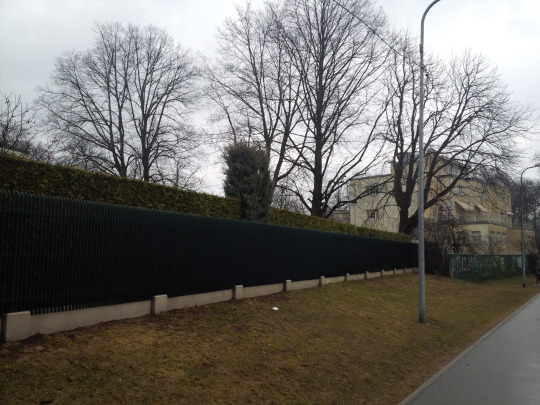
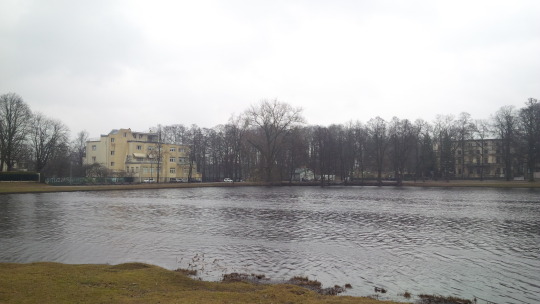


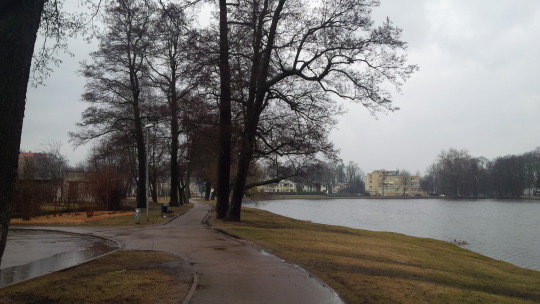
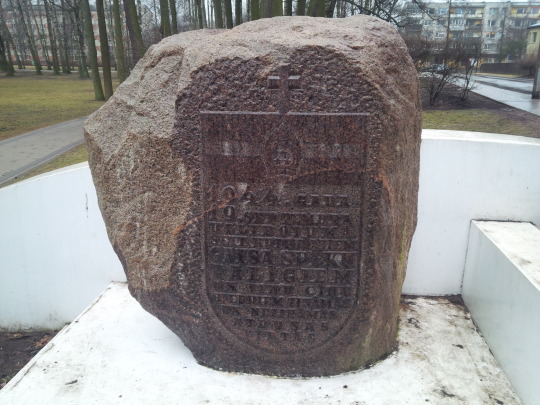
Having walked around the pond, we headed straight down Mārupes iela where there was a mix of residential buildings and student housing for Rīgas Stradiņa universitāte, the country’s most famous medical university named after famous Latvian surgeon Pauls Stradiņš. We also passed one of the city’s few Baptist churches, one of the “Coffee Tower” cafes which Konstantin mentioned tried to buy the water tower, and a Rimi.
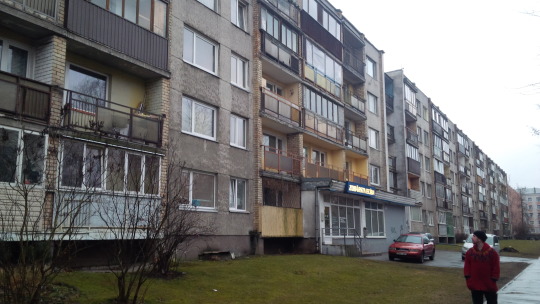
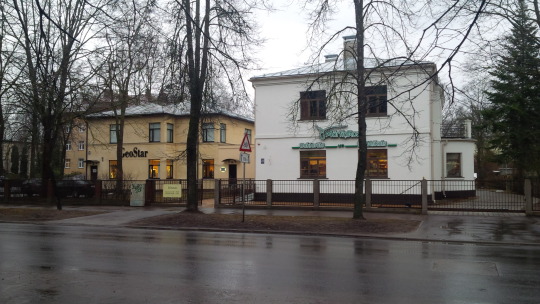
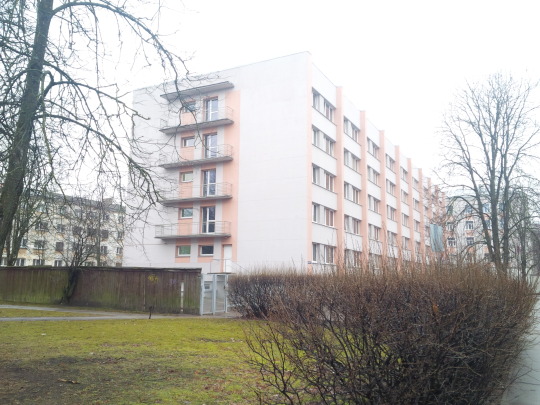
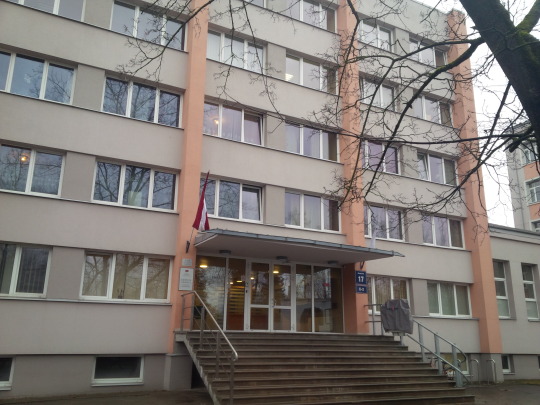


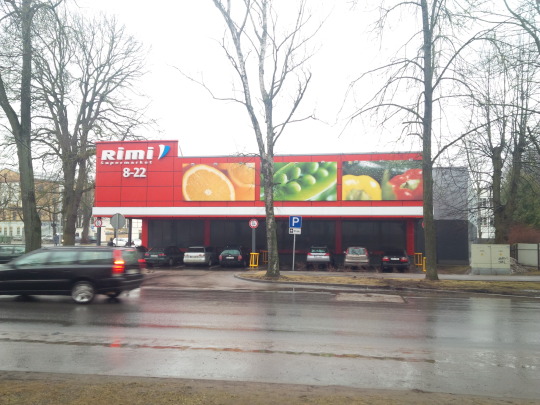
We turned left onto Leipājas iela, where we saw some graffiti that warned us: “beidz izdomāt melus” (stop making up lies). Within a few minutes we were standing outside of Sv. Alberta baznīca, an important part of Rīga’s Catholic community. Originally intended to be built in French Baroque style, starts and stops to the construction resulted in the somewhat unique final design. Across the street behind the brick wall was the many historic buildings on the campus of Stradiņa klīniskā universitātes slimnīca (the university hospital). Unfortunately we did not have the opportunity to explore the campus, but we were so wet and cold at this point that we were ready to take the bus to our final destination: Uzvaras Parks.




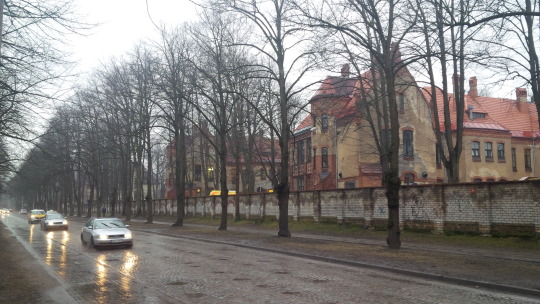

Since turning towards the market, our path had looked like this:
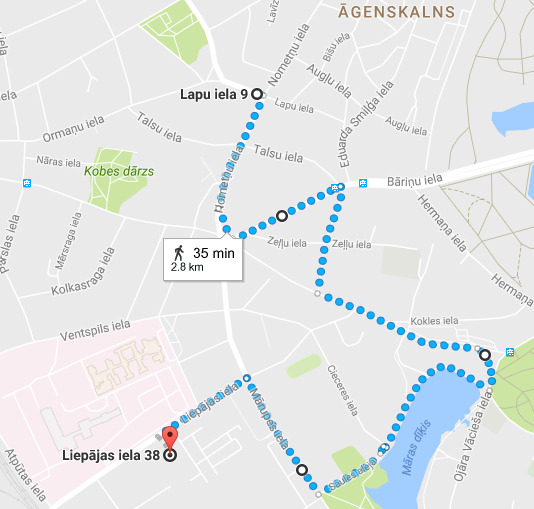
We got off at Slokas iela in front of Zelta Boulings, Rīga’s most popular bowling alley with some of the most surpisringly good pizza found in the city. We backtracked a bit down Uzvaras bulvaris to come to our final stop in the Āgenskalns and one of the city’s most controversial locations: Uzvaras piemineklis (Victory Memorial).

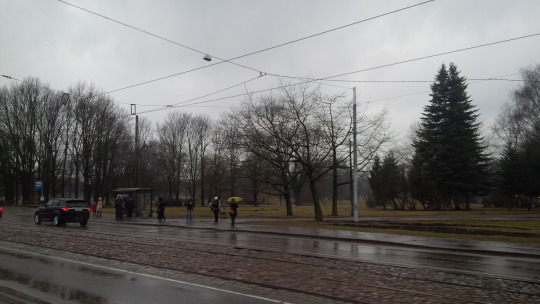

While the end of WWII and the defeat of the Nazis is celebrated throughout the world, many in Latvia (particularly ethnic Latvians) see the end of WWII as the beginning of the Soviet Union’s occupation of the country which included the forced deportations and murders of tens of thousands of Latvians. The monument was built in the early 1980s and is one of the most physically impressive sites in the entire country, but there have been many calls to demolish it as most other Soviet-era statues were at the re-establishment of Latvian independence. In fact, two ultra-nationalists even tried blowing the monument up in 1997, but ended up dying with the statue mostly unharmed. The site is especially important to the city’s ethnic Russian community which makes up nearly a majority of Rīga’s residents, many of whom had family who fought proudly to defend their country against the Nazi invaders. Many ethnic Russians feel alienated and left behind by the Latvian government's policies since 1991 regarding citizenship and language, and removing the statue would inevitably cause significant tension. For the foreseeable future the statue will remain as a divisive symbol which means many things to many people, and I will write more about the issue for the upcoming May 8th/9th celebration of V-E Day. What is undeniable, however, is that the Soviets knew how to make impressive and awe-inspiring statues.





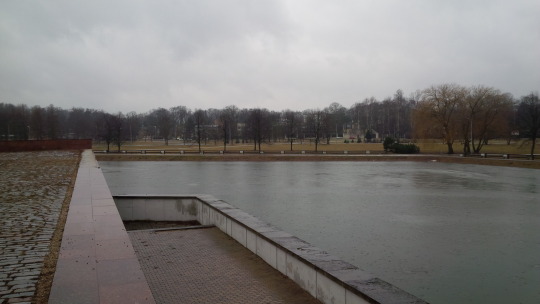


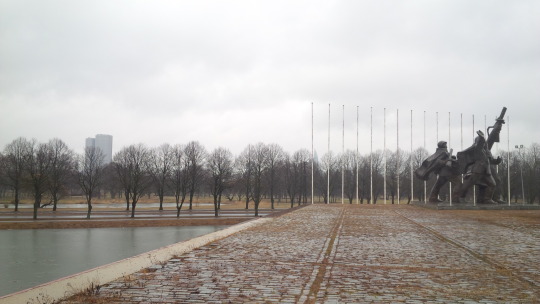
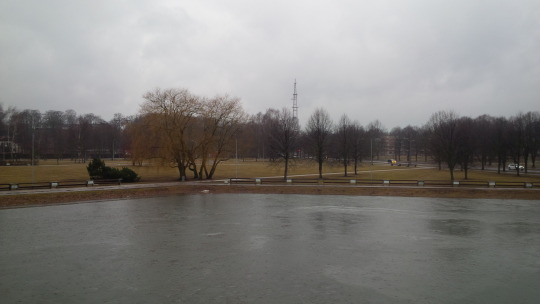
The final part of Āgenskalns that we skipped over was the rest of Uzvaras parks, but we were so cold and wet by now that we decided to go home. Plus, the rain was so heavy by now that the pictures we would have taken wouldn’t have done justice to the beautiful park. Instead, I will cheat with a few pictures we took of the park from last spring.



I hope that these rainy and dark pictures haven’t discouraged you, because visiting Āgenskalns is an absolute no-brainer regardless of your personal interests. While I usually recommend visiting certain neighborhoods to certain people for various reasons, Āgenskalns is one of the only ones I can suggest without any hesitation or second thoughts. If you’ve been in Rīga for any significant amount of time I’m sure you’ve alresdy spent some time here, but if you somehow haven’t yet wandered across the bridge to Pārdaugava then it’s time to come and visit.
A few random observations:
While most people I know who have lived outside of Rīga’s center have told me that they don’t do much in those neighborhoods aside from living and do most other things in the center, most of the people I know who live in Āgenskalns spend a significant amount of their time there. This is unsurprising considering how much there is to do and see here, but it really almost feels like a separate city with a somewhat different feel to it.
That being said, Līga and I have spent surprisingly little time in Āgenskalns. Although there’s so much to do, I have usually seen it from the windows of busses going to and back from work at the LU Pedagogy Faculty in Imanta. From Ķengarags it takes just a tiny bit too long to get to compared to the center where you can find almost anything that Āgenskalns has, but if I already lived in Pārdaugava I’m sure I’d spend more time here than time across the bridge.
Although we thought that winter had just about completely passed at this point in mid-March, we woke up this morning in mid-April to fairly heavy snowfall. To say that winter/spring 2017 has been a curveball would be quite an understatement.
And that’s it for now. I apologize that this post has been a bit longer than the others, but there is just so much to show and talk about in Āgenskalns that I didn’t want to leave anything out. Also a huge special thanks to Konstantin for contributing so much historical information about the neighborhood and its buildings, another reason why this post is a bit longer than the others. He’s planning on coming with us more regularly on our walks through the neighborhoods, and he might contribute some other posts in the future about urban exploration and other Rīga-related topics. Until next time, let’s hope that spring will soon finally stick around!
Nākamā Pietura: Atgāzene!
(Edit: Thanks to Māris Goldmanis from the fantastic Latvian History blog who wrote in with additional information a bout the state archives and the TV tower after the post was first published)
#agenskalns#Āgenskalns#riga#Rīga#Latvia#Latvija#soviet architecture#architecture#art nouveau#latvian history#old riga#Rīgas pilsēta#Vecrīga#Vecriga#water tower#city exploration#urban exploration#urbanexploration#urban explorers#urbandecay#abandoned buildings#abandoned places#Рига#Pārdaugava#riga stradiņš university#z-towers#uzvaraspiemeneklis#uzvarasparks#Латвия#public transit
2 notes
·
View notes